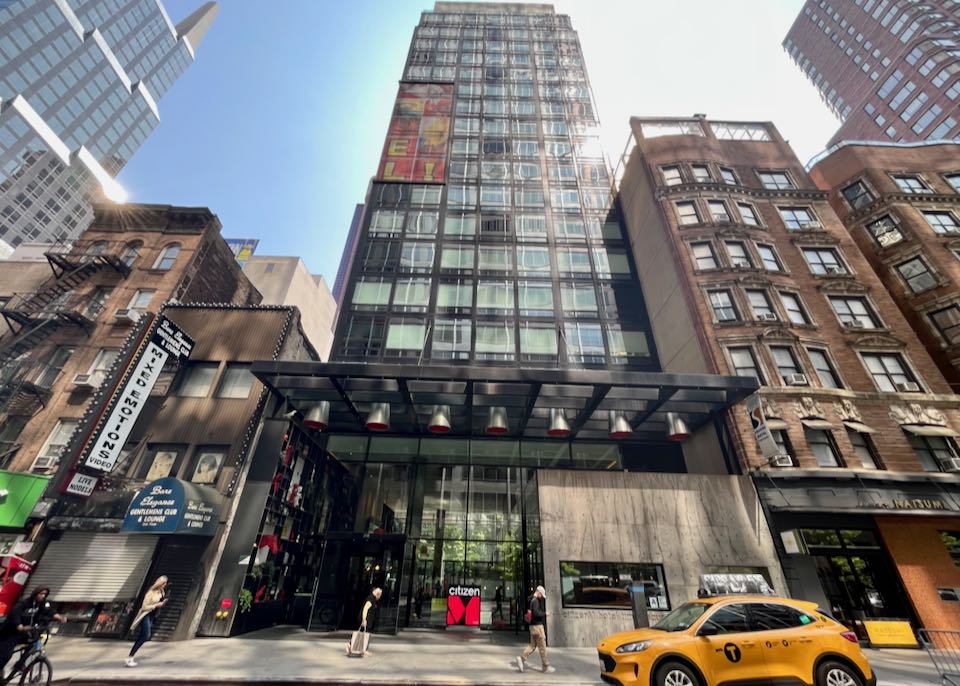
Trendy yet affordable citizenM hotel near Times Square. All rooms have the same layout with one king bed. Great for singles, or couples on a budget.
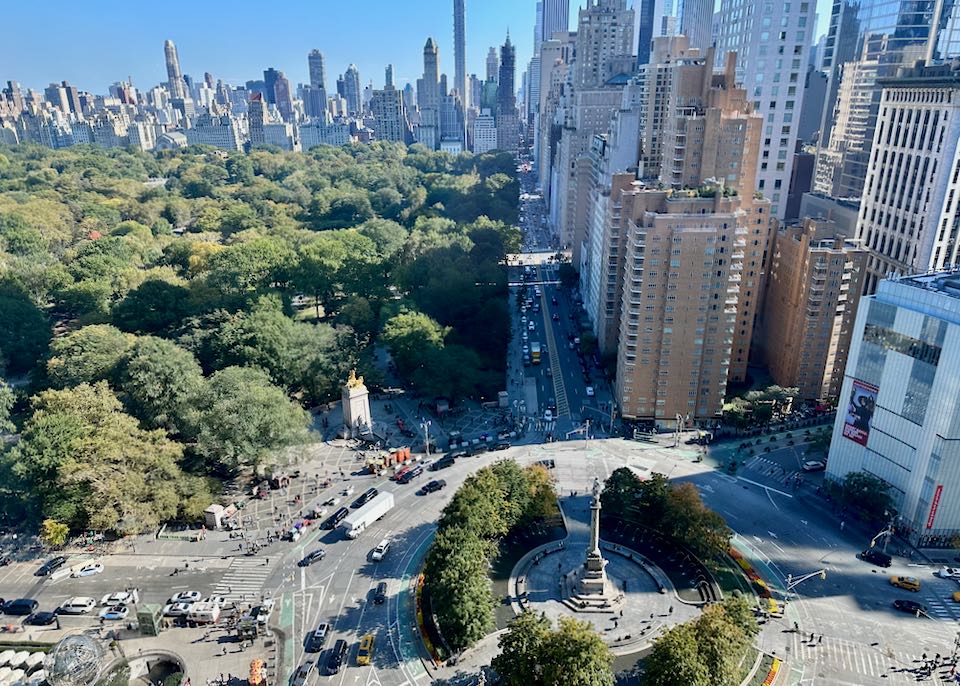
The view of Central Park and Columbus Circle from the Mandarin Oriental – my favorite hotel in New York City.
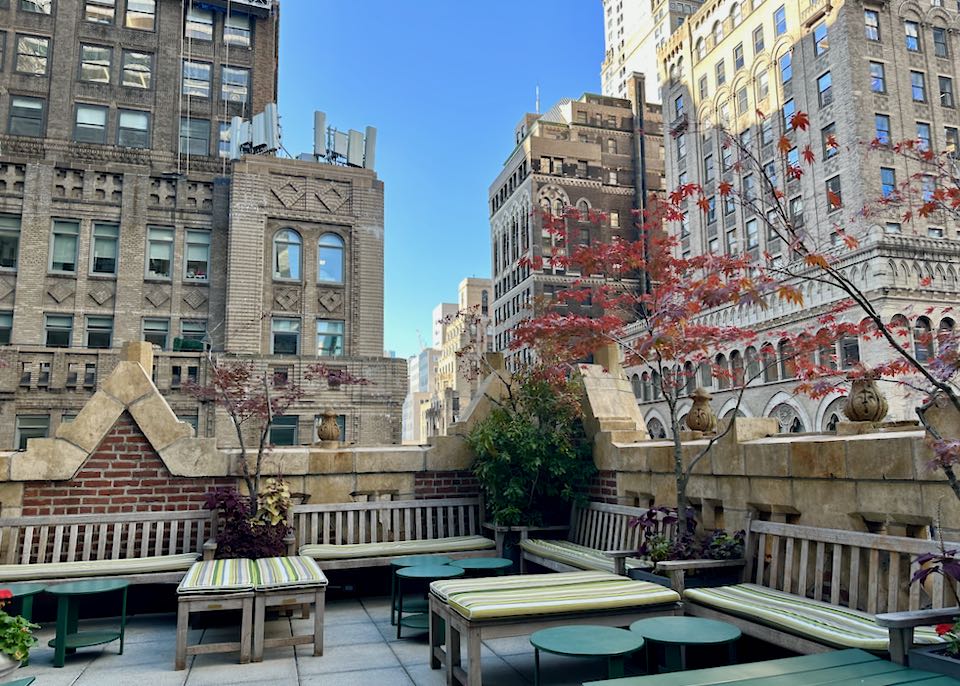
The Library Hotel is fantastic for couples looking for a reserved calm in the heart of Midtown. I stayed here on my most-recent visit.
Best Areas to Stay in New York City
My wife and I during a walk along the High Line in New York City.
On my first few visits to New York I always stayed close to Times Square and the Theater District. And this is what I recommend for most visitors (whether first-time or return). Pretty much any hotel in Midtown will put you within walking distance of Times Square, Broadway performances, Rockefeller Center, the Empire State Building, 5th Avenue shopping, the Museum of Modern Art, and Central Park.
For those looking to stay a little off the tourist trail, there are now good (though not necessarily cheaper) hotels in almost every district of Manhattan, as well as over in Brooklyn and Queens.
The Sheraton Times Square has a fantastic location in the Theater District and an easy walk to Central Park. There’s a subway station (visible in photo) directly beside the hotel.
Good hotels in Midtown, close to Times Square:
Sheraton Times Square • AKA Times Square • Margaritaville Times Square • citizenM • Hilton Garden Inn Times Square Central • Riu Plaza Times Square • Pod Times Square • LUMA Hotel – Times Square • Crowne Plaza Times Square • Edison Times Square • Westin at Times Square • Andaz 5th Avenue
NYC Neighborhoods
New York City is divided into five boroughs, though for many visitors “New York” is synonymous with only one: Manhattan.
Midtown Manhattan is renowned as the vibrant heart of New York City, boasting iconic landmarks like Broadway and Times Square, along with many of the city’s tallest skyscrapers and premier hotels. While it stands as a pivotal business and financial hub, it’s worth noting that Midtown may not have the same distinctive charm found in the city’s more residential areas. However, it’s well served by subway and packed with top-tier tourist attractions, making it an exceptionally central and convenient location for first-time visitors.
To the north of Midtown lies Central Park, flanked by the upscale residential areas of the Upper West Side and Upper East Side (which contains Museum Mile). Harlem lies north of Central Park, with Washington Heights and Inwood the main neighborhoods at the northern tip of Manhattan.
Downtown Manhattan contains the Financial District and some major sights such as the 9/11 Memorial and Wall Street. In between here and Midtown lie some of Manhattan’s most interesting neighborhoods, primarily residential areas but with hip nightlife and diverse culinary scenes: the East and West Villages, Soho, Chelsea, the Lower East Side, Chinatown, and Tribeca.
Outside of Manhattan, New York City’s other boroughs can also be great places to stay: Brooklyn is a major city in its own right, with Park Slope, Fort Greene, Williamsburg, and Carroll Gardens loaded with assorted attractions, restaurants, and bars. Queens is similarly diverse, with several attractions like the Noguchi Museum and an amazing array of multi-cultural restaurants. The Bronx is best known for Yankee Stadium, the Bronx Zoo, and New York Botanical Garden, while sleepy Staten Island is the most suburban New York borough, easily skipped by first-time visitors (though the free Staten Island Ferry is worth taking for the views alone).
The Best Places to Stay in NYC
The Beekman in Lower Manhattan.
- Best Luxury Hotels in NYC
The Beekman • Lowell Hotel • Mandarin Oriental • Pendry Manhattan West • The Peninsula • The Pierre • The Wallace • Wall Street Hotel- Best Hotels for Families
Lowell (luxury) • AKA Times Square (midrange)- Best Boutique/Honeymoon Hotels for Couples
Archer Hotel • Library Hotel • Crosby Street Hotel • Mint House at 70 Pine • Nine Orchard • Whitby Hotel- Best Midrange Hotels in NYC
Artezen Hotel • Best Western Plus Soho • citizenM Bowery • citizenM Times Square • Hotel Mimosa • The Jewel Hotel • Staypineapple Midtown- Best Cheap Hotels in NYC
La Quinta Times Square South • Pod 39- Best Hostels in NYC
American Dream • HI NYC • Kama Central Park • The Local NY
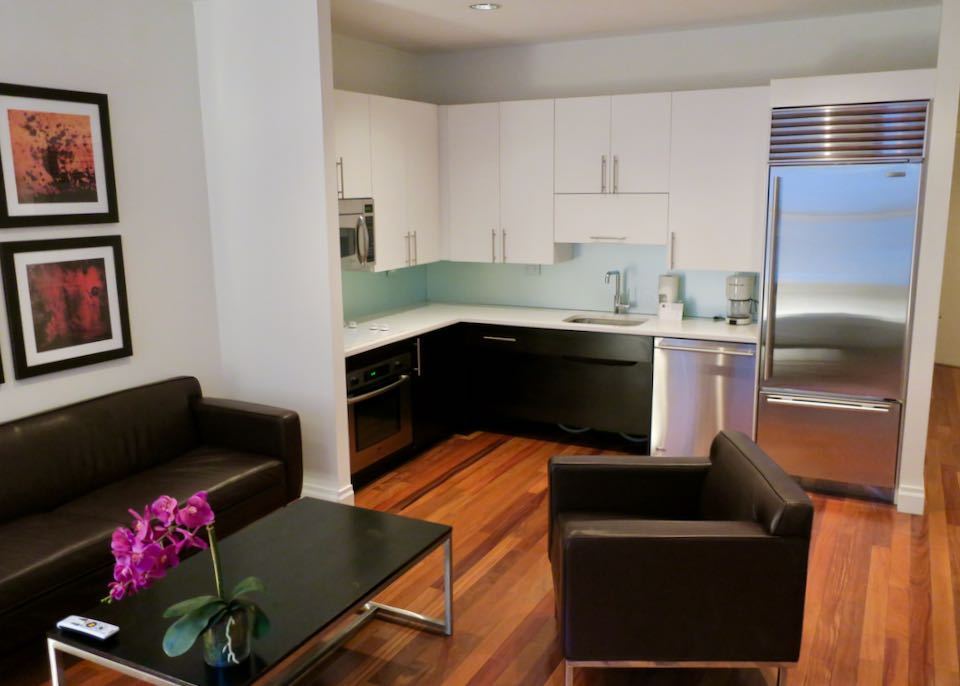
Our suite at the AKA Times Square in Midtown. One and two bedroom apartments available. Great for families.
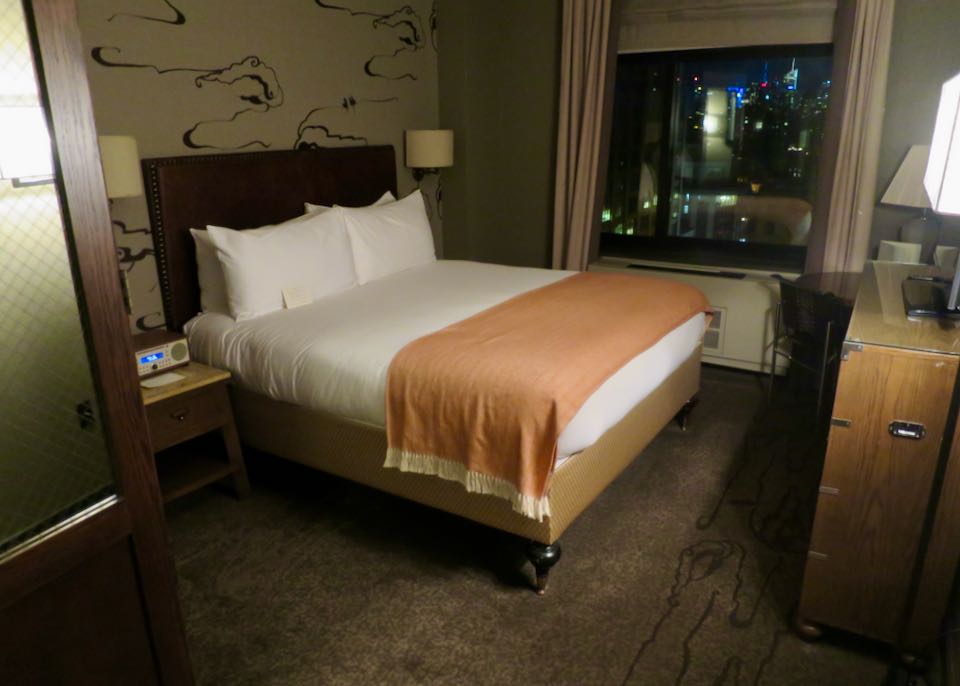
Our suite at the Soho Grand Hotel.
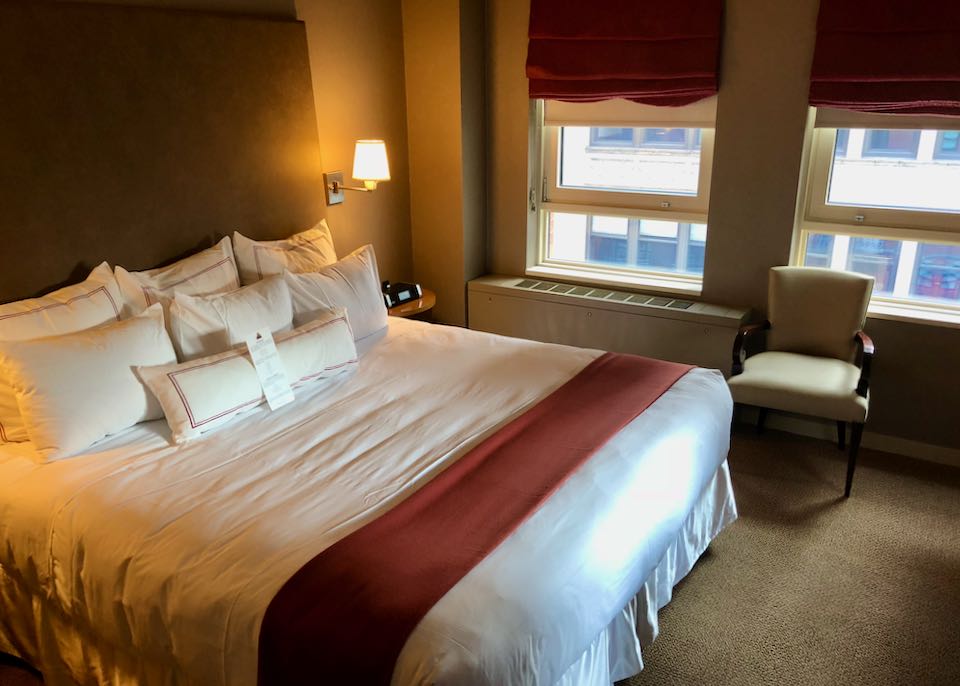
Our suite at the Giraffe Hotel near Washington Square Park.
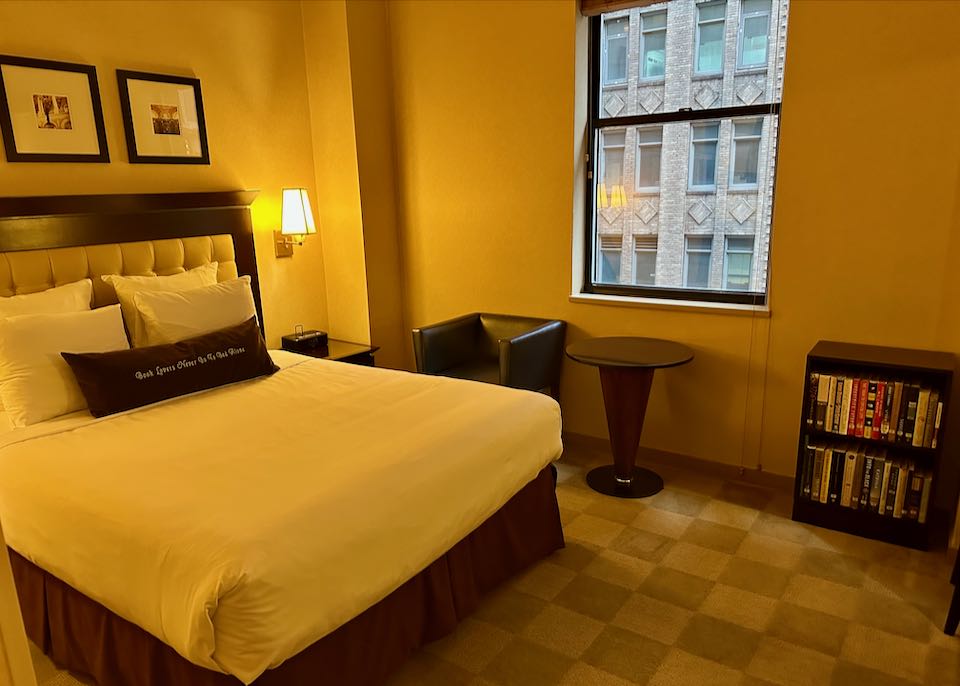
Our suite at the Library Hotel.
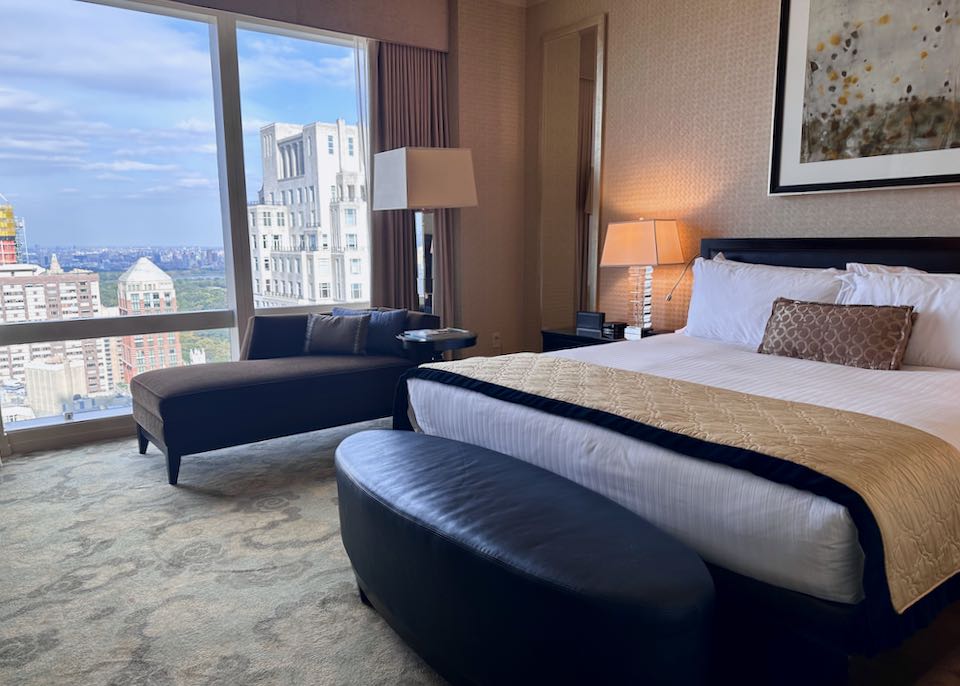
Our suite at the Mandarin Oriental.
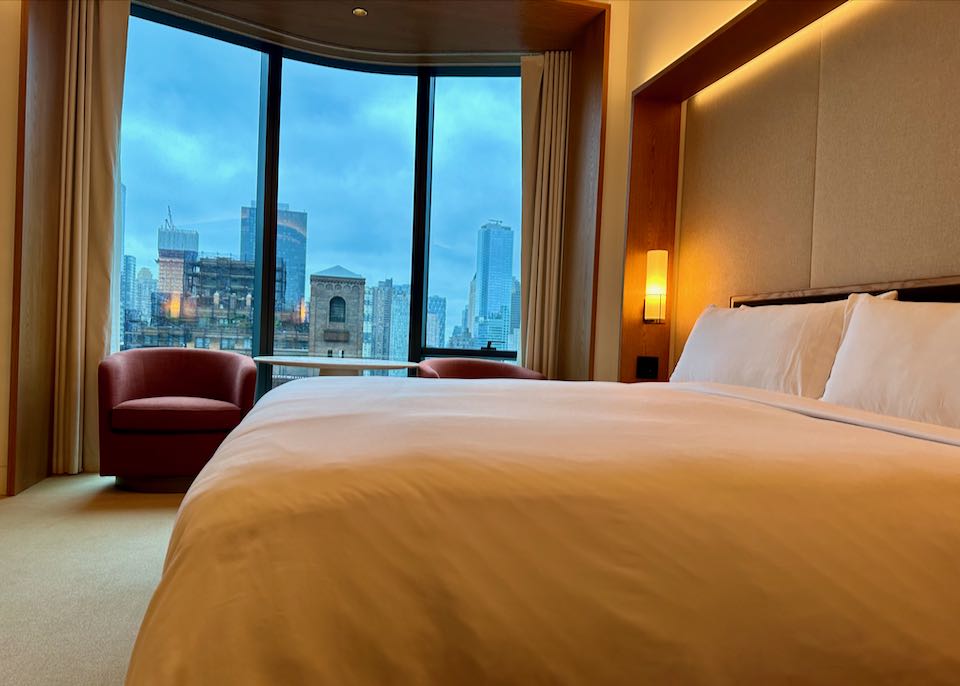
Our suite at the Pendry Manhattan West.
Note that genuinely cheap hotels and hostels are now rare in New York City due to a variety of factors, such as the emergence of Airbnb and apartment rentals, which present a competitive challenge. Furthermore, a number of these establishments have been repurposed by the city authorities to serve a greater societal purpose, offering accommodations for international migrants and those without homes.
Best Neighborhoods in NYC for…
- Best NYC Neighborhood for First-Time Visitors: Theater District (Midtown)
Yes, it’s crowded, but there is no more convenient home base than the Theater District in Midtown Manhattan, roughly 42nd Street to 50th Street west of Sixth Avenue. This is the New York of popular imagination, with canyons of skyscrapers and the greatest variety of lodging choices – and it’s an easy walk to Fifth Avenue, Times Square, and the theaters. The great central location eliminates the need to fight crowds for transportation after a Broadway show, and it’s not far to major attractions like MoMA, the Museum of Broadway, Empire State Building, New York Public Library, and Rockefeller Center. Another plus: The 42nd Street Broadway subway stop is served by many lines, making it easy to visit other parts of the city. Dining options around here aren’t the best in the city, but there’s a huge amount of choice and plenty of budget options.The Peninsula Hotel in Midtown, close to Central Park, 5th Avenue shopping, and Times Square.
The Margaritaville Times Square – has the only outdoor year-round (heated) pool near Times Square.
- Best NYC Neighborhood for Sightseeing: Midtown
The greatest concentration of attractions is undeniably in Midtown. This neighborhood is not only the epicenter of New York shopping and theater, but it also houses some of the city’s most iconic buildings: The United Nations, the New York Public Library, Grand Central Terminal, Rockefeller Center, Empire State Building, Chrysler Building, and now the new Hudson Yards district and soaring Vanderbilt Tower. Other attractions include the Museum of Modern Art (MoMA), Spyscape (the modern spy-themed museum), Madame Tussauds, the Museum of Broadway, the Intrepid Sea, Air & Space Museum, Carnegie Hall, and the Morgan Library & Museum. Midtown also has the largest stock of hotel accommodation and is an ideal central location for exploring the rest of the city.- Best NYC Neighborhoods for Foodies: East Village & Williamsburg (Brooklyn)
Downtown Manhattan – especially the East and West Villages, Tribeca, SoHo, and the Lower East Side, tends to contain the most diverse, cutting-edge restaurants in the city, from vegan burgers sold from a hole-in-the-wall to celebrity chefs and Chinatown staples. Overall, we like the East Village most, where there’s an incredibly diverse dining scene at reasonable prices. It’s packed with old-school favorites like Ukrainian diner Veselka and historic Italian café Veniero’s, the wildly popular veggie burgers at Superiority Burger, Tex-Mex at Yellow Rose, and David Chang’s noodles and pork buns at Momofuku Noodle Bar (his two-Michelin starred flagship Momofuku Ko is best for a splurge). Andrew Carmellini’s Lafayette is an elegant spot for brunch, while Motorino serves some of the best pizzas in the city.In Brooklyn, Williamsburg tends to have the most exciting dining scene; Italian restaurant Lilia, old-school Bamonte’s, The Four Horsemen, and Sushi on Me are just a few of the highlights, while Michelin-starred Aska (new Scandinavian) and nearby classic Peter Luger Steak House epitomize new and old New York. In the summer it’s worth checking out Smorgasburg, New York’s best open-air snack and food market.- Best NYC Neighborhood for Families: Upper West Side
Bordered by parks and playgrounds and boasting both the Children’s Museum of Manhattan and the iconic dinosaurs of the American Museum of Natural History, the Upper West Side is an excellent neighborhood for families. Several hotels here offer family-friendly accommodations, and the area is served by two subway lines and several buses, making it easy to get around.The Upper West Side’s Museum of Natural History.
A Knicks, Liberty, or Rangers game at Madison Square Gardens is a highlight of a New York visit. The best hotels near MSG are the Renaissance and Hampton Inn Madison Square Garden.
The start of the High Line, steps from one of my favorite hotels, the Pendry Manhattan West.
- Trendiest Manhattan Neighborhood: Nolita
The fast-evolving Nolita (North of Little Italy) district south of Houston Street between SoHo and the Lower East Side’s Bowery is home to the avant-garde New Museum of Contemporary Art, sleek art galleries (like Westwood and Sperone Westwater), hip boutiques (like Supreme skate shop and Tombolo), and an expanding list of trendy new hotels (like the hip Moxy Lower East Side) and restaurants. There are still rough edges here but there’s no better place to experience the vibes of change in New York. The citizenM Bowery is an excellent choice for an overnight stay.- Best Place to stay in NYC for Christmas/New Year’s Eve: Midtown
Midtown Manhattan is where the Christmas action takes place, especially along Fifth Avenue: huge street decorations, the ice-skating rink and soaring Christmas tree in Rockefeller Center, and famously elaborate window displays in department stores like Saks Fifth Avenue and Bloomingdale’s. Though it’s cold at this time of year, the weather is generally dry and sunny, but note that the streets are often jam-packed with visitors and locals alike (especially on Fifth Avenue and around Rockefeller Center), who come out to enjoy the festivities. Christmas Day itself tends to be quieter, with most shops and attractions closed, though plenty of restaurants remain open.The focus at New Year’s Eve is on Times Square, where there’s a massive party and the “ball-drop” at midnight – you’ll need to arrive early in the afternoon to secure a good spot (the roads around Times Square are usually locked down by late afternoon). Outside of Manhattan, the Brooklyn neighborhood of Dyker Heights is so famous for its crazy, over-the-top holioday decorations, it has its own guided tours (easily arranged from your hotel in Midtown).- Best Place to stay on a budget: Queens
You can save money by considering hotels outside Manhattan; hotels and notably apartment rentals (Airbnb or VRBO) in Queens. Hotels across the East River and in Jersey City across the Hudson can be 50 percent cheaper than those of similar quality near Times Square. In most cases, these will be a short subway (Queens) or bus (Jersey) ride from central Manhattan. Both neighborhoods are closer to Manhattan than they might seem.- Best Place to stay for Young Adults: Williamsburg (Brooklyn)
One subway stop from Manhattan, Williamsburg is one of New York’s hippest neighborhoods; the haunt of young professionals, students, and an artsy, alternative crowd. Enjoy stylish boutique hotels, some of the best restaurants in the city, and a dynamic nightlife. Local stalwarts like the Brooklyn Brewery and Pete’s Candy Store (bar) have been joined by Schimanski nightclub, live music venue (and bowling alley) Brooklyn Bowl, and the Music Hall of Williamsburg. On summer weekends the Smorgasburg open-air food market occupies the waterfront and locals flock to McCarren Park to picnic and sunbathe. (The McCarren Park Pool is one of the city’s best and largest public swimming pools).- Best Place to Stay for the Weekend: Greenwich Village (West Village)
The most beautiful neighborhood in Manhattan, the West Village is ideal for a fun weekend getaway. It’s one of the epicenters of New York brunch culture, with justly popular spots such as Jack’s Wife Freda, Joseph Leonard, and Jeffrey’s Grocery just the tip of the iceberg. Washington Square Park is like a giant open-air bazaar and entertainment zone rolled into one at the weekends; packed with sunbathers, picnickers, chess-players, street artists and musicians. While over on the Hudson River, the Hudson River Greenway is a breezy promenade dotted with cafes and gardens. In the evening, hit some of the city’s most famous nightspots: the Comedy Cellar, Blue Note Jazz Club, Village Vanguard, Cafe Wha?, Minetta Lane and Cherry Lane theatres, plus legendary LGBT venues like The Stonewall Inn and The Monster.
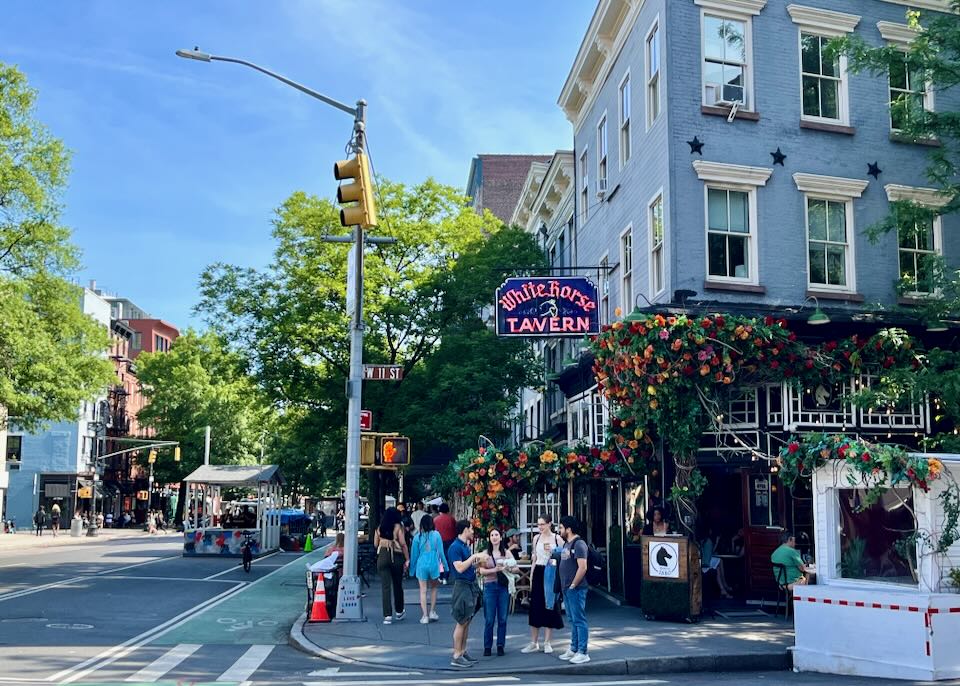
The historic White Horse Tavern in Greenwich Village

The 5-star Equinox Hotel, located across from the Edge (outdoor viewing deck), Hudson Yards (a high end indoor mall), and a subway station.
- Best Place for Local Vibe: Greenpoint (Brooklyn)
Set between the East River and Brooklyn’s northern border with Queens, Greenpoint retains plenty of local color, despite gradual gentrification over the last decade or so. (And the popularity of TV show Girls, which featured local coffee shop Café Grumpy). It’s home to the largest Polish community in New York, most in evidence along the main strip, Manhattan Avenue, lined with Polish restaurants and bakeries (like Polka Dot and Pierozek). It’s also home to some of the borough’s best hotels: the Henry Norman, the Box House Hotel and the Franklin Guesthouse.- Best Place for Shopping: Midtown or SoHo
Midtown Manhattan contains the most shops, particularly the higher-end strip along Fifth Avenue (Bergdorf Goodman, Saks Fifth Avenue, Tiffany & Co, and Cartier), and the chains around Herald Square, dominated by Macy’s department store. However, SoHo is a better hub for luxury boutiques, hip designers, and niche brands. Here you’ll find Prada, Nike, Polo Ralph Lauren, Burton snowboards, Louis Vuitton, Rag & Bone, Kate Spade, Muji, Levi’s, Rudy’s Music guitars, and 2nd Street SoHo vintage fashion.- Most Romantic Destination: Upper East Side or Greenwich Village (West Village)
Midtown Manhattan incorporates the most classic New York cityscapes and experiences (and some of the most romantic hotels, such as The Plaza), but the Upper East Side is a more thoughtful choice. Upscale and more residential, the hotels here ooze old New York charm, and you are never far from Central Park and Museum Mile.There’s not much choice when it comes to hotels in Greenwich Village (aka West Village), but it’s another charming neighborhood. Its narrow lanes are lined with historic brownstones and row houses, indie boutiques, and some of the best restaurants in the city. The Hudson River Greenway promenade makes a romantic spot for a stroll at sunset, and there are plenty of jazz clubs, cocktail bars, and historic pubs to enjoy in the evenings.- Best NYC Neighborhoods for Nightlife: Meatpacking District, Lower East Side & Williamsburg
It’s lost some luster over the years, but the Meatpacking District remains a hub for upscale nightlife. The sidewalks are crowded with young fun-seekers until late at night in this happening area, home to many popular cafes and dance clubs. In and around The Standard High Line hotel you have Top of The Standard, Brass Monkey, Standard Biergarten, and Le Bain nightclub, while the nearby Gansevoort Hotel features a stylish rooftop bar. We also like The Tippler and Corkbuzz inside Chelsea Market, and the nearby Discolo (inside Al Coro restaurant).But New York nightlife isn’t confined to one neighborhood. The Lower East Side remains a hub for edgier bars and clubs, with Daphne, Loosies (inside the Bowery Grand Hotel), Outer Heaven, and Virgo popular clubs; and Bar Valentina, Verlaine, Mercury Lounge, and Fools Gold top of a very long bar list. A lot is also happening across the East River in Brooklyn’s Williamsburg, where old favorites like the Brooklyn Brewery and Pete’s Candy Store have been joined by Ciao Ciao Disco, The Water Tower Bar, Westlight, 320 Club, Barcade, and Cafe Balearica.Chelsea is the city’s LGBTQ nightlife hub, and more clubs, both straight and gay, are found in “Hell’s Kitchen,” a neighborhood in the 40s west of 9th Avenue. For jazz bars and clubs, check out Greenwich Village.- Best Neighborhoods Without a Car: West Village & Lower East Side (including Nolita, Chinatown, and Little Italy)
Manhattan’s most walkable neighborhoods tend toward Downtown (south of 14th Street), where the traffic is generally lighter, the roads narrower, and where the city street grid is less rigid (or in the case of Greenwich Village, disappears altogether). The West Village boasts incredibly charming streets, best appreciated on foot: Bedford Street, West 4th Street, and Bleecker Street feature beautiful townhouses, indie boutiques, and intimate restaurants. Washington Square Park is one of the city’s most lively green spaces, especially at the weekend.The Lower East Side sees a little more traffic but all the key neighborhoods here – Little Italy, Chinatown, Nolita – are very close together and best explored on foot. In Chinatown, food stalls loaded with fruits, vegetables, and snacks line the sidewalks, while small bars and restaurants pepper the Lower East Side.
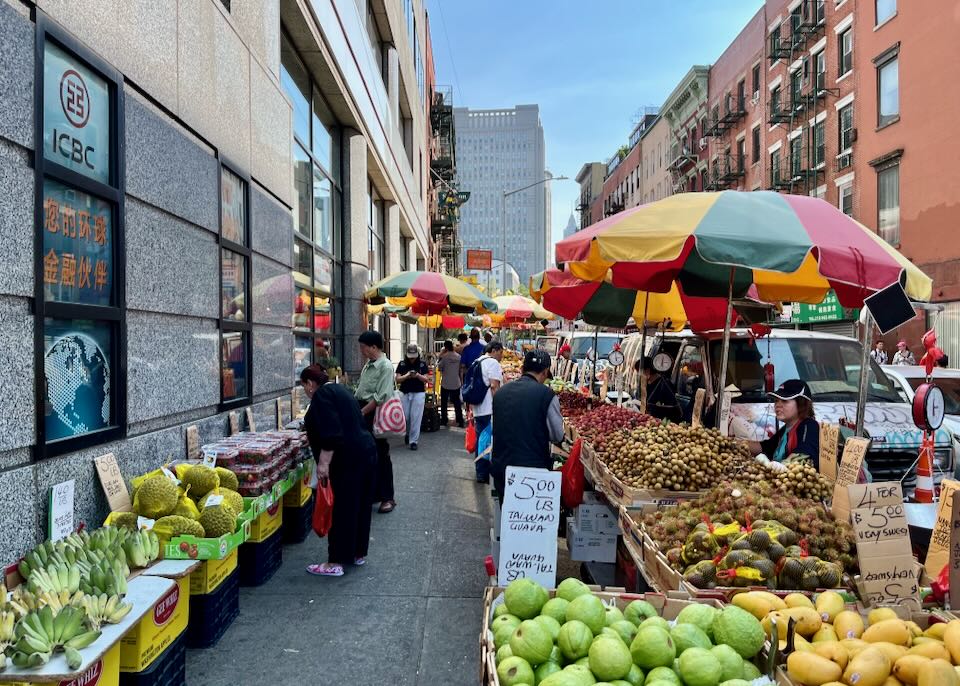
Streetside produce stalls in Chinatown
- Best Outer Neighborhoods for easy access to Manhattan: Fulton Ferry District (Brooklyn) or Long Island City (Queens)
Tiny Fulton Ferry District, sandwiched between the East River, Brooklyn Heights, and Dumbo, has the best connections to Downtown Manhattan, a cluster of gleaming skyscrapers just across the water. Though the nearest subway station (High Street – Brooklyn Bridge) is a short walk inland, it’s possible to walk across the Brooklyn Bridge from here or take one of the convenient (and cheap) NYC Ferry services across to Wall Street. The Fulton Ferry District is also the home of the borough’s best hotel, 1 Hotel Brooklyn Bridge.Further north, Long Island City (Queensboro Plaza/Court Square-23 St/Vernon Blvd-Jackson Av) is just one subway stop from Midtown and the Upper East Side (you can also take ferries across from the Hunters Point South and Long Island City docks). Aloft Long Island City, Hyatt Place Long Island City, LIC Hotel, and The Local NY are good places to stay over here.- Safest Areas of NYC: Upper East Side, Upper West Side, Lincoln Center
Safety generally is not an issue in New York, one of the country’s safest big cities. But for those who are concerned, consider staying in the Lincoln Center area or the quiet residential Upper East and Upper West sides. Among these, the Upper West Side has more reasonable prices. The neighborhoods of East New York and Brownsville (in the far eastern reaches of Brooklyn) still post relatively high rates of crime compared to other parts of New York, but there is no compelling reason for travelers to visit either place.The 10 Best Neighborhoods in NYC for Tourists
1. Midtown
Times Square, the bright lights of the Broadway Theater District, Fifth Avenue shopping, the landmark architecture of Rockefeller Center, the Empire State Building, St. Patrick’s Cathedral, the iconic Chrysler Building, New York Public Library’s main branch, the Museum of Modern Art, the United Nations complex, and dining choices from budget to haute cuisine are all found in this area, the very heart of Manhattan.
In terms of lofty observation decks, the stalwart Empire State and Top of the Rock (Rockefeller Center) have newer competition in the form of SUMMIT One Vanderbilt and the Edge, a jaw-dropping open-air platform over in Hudson Yards, one of the city’s newest cluster of skyscrapers. The huge copper-colored “Vessel” installation by Thomas Heatherwick is also here, and the development forms the northern end of the High Line (an elevated train line converted into a park). There’s also the brand-new Museum of Broadway, spy-themed Spyscape, and more traditional attractions such as Madame Tussauds New York and the Intrepid Sea, Air & Space Museum, a decommissioned aircraft carrier over on the Hudson River which contains the retired space shuttle Enterprise.
Midtown is a must for visitors and has the city’s largest concentration of hotels.
Note that the iconic Waldorf-Astoria New York is likely to remain closed until late 2024 or 2025 for a major renovation. The Four Seasons Midtown hotel also remains temporarily closed for “substantial infrastructure and maintenance work” that will keep the hotel closed until fall 2024.
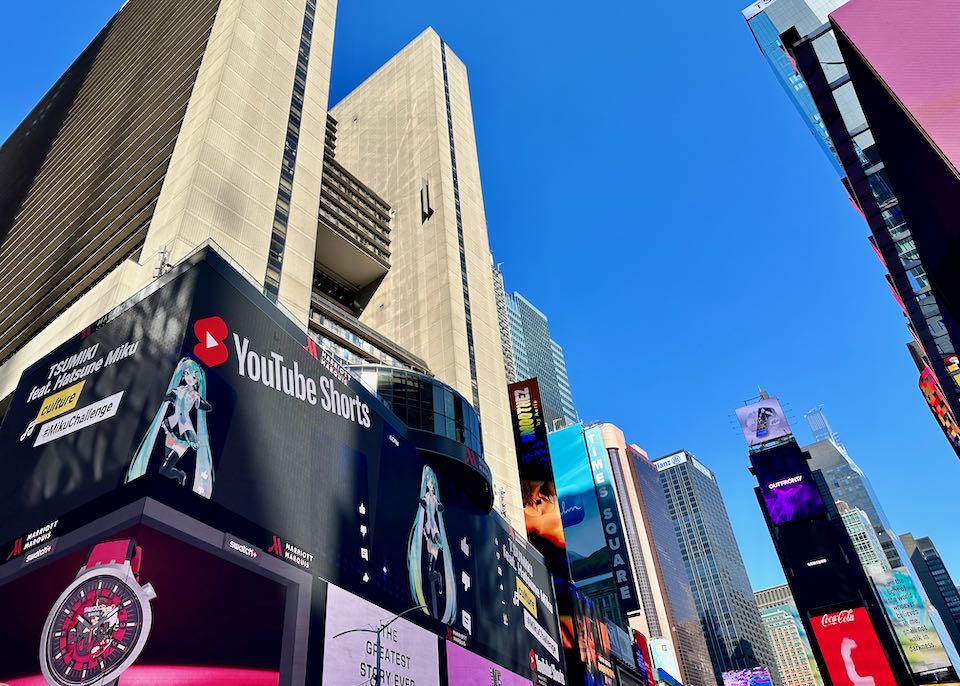
The Marriott Marquis in Times Square is as central as you can get.
- Best Hotels in Midtown Manhattan
Archer Hotel • Hotel phone: +1 (212) 719 4100
Andaz 5th Avenue • Hotel phone: +1 (212) 601-1234
Baccarat Hotel • Hotel phone: +1 (212) 790-8800
Casablanca Hotel • Hotel phone: +1 (212) 869-1212
Equinox Hotel Hudson Yards • Hotel phone: +1 (212) 812-9200
The Kimberly Hotel • Hotel phone: +1 (212) 755-0400
The Langham Fifth Avenue • Hotel phone: +1 (212) 695-4005
Library Hotel • Hotel phone: +1 (212) 983-4500
LUMA Times Square • Hotel phone: +1 (212) 730-0099
Pendry Manhattan West • Hotel phone: +1 (212) 933-7000
The Peninsula • Hotel phone: +1 (212) 956-2888
Renaissance Midtown • Hotel phone: +1 (212) 239-0014
Ritz-Carlton Central Park • Hotel phone: +1 (212) 308-9100
Whitby Hotel • Hotel phone: +1 (212) 586-5656- Best Midrange Hotels
AKA Times Square Apartments • Hotel phone: +1 (212) 764-5700
Arlo Midtown • Hotel phone: +1 (212) 343-7000
citizenM Times Square • Hotel phone: +1 (212) 461-3638
The Draper • Hotel phone: +1 (212) 645-0080
Edison Times Square • Hotel phone: +1 (212) 840-5000
EVEN Times Square South • Hotel phone: +1 (212) 356-0034
Hilton Garden Inn Times Square Central • Hotel phone: +1 (212) 840-9600
The Jewel Hotel • Hotel phone: +1 (212) 863-0550
Margaritaville Times Square • Hotel phone: +1 (212) 221-3007
Marriott Marquis • Hotel phone: +1 (212) 398-1900
Riu Plaza Times Square • Hotel phone: +1 (646) 864-1100
Sheraton Times Square • Hotel phone: +1 (212) 581-1000
Staypineapple • Hotel phone: +1 (866) 866-7977
Westin at Times Square • Hotel phone: +1 (212) 201-2700- Best Cheap Hotels
Crowne Plaza Times Square • Hotel phone: +1 (212) 977-4000
Hotel 57 • Hotel phone: +1 (212) 753-8841
La Quinta Times Square South • Hotel phone: +1 (718) 690-3294
Pod 39 • Hotel phone: +1 (212) 865-5700
Pod Times Square • Hotel phone: +1 (844) 763-7666- Best Hostel
American Dream • Hotel phone: +1 (212) 260-97792. Upper West Side & Central Park
From the luxury buildings skirting Central Park West to side streets lined with classic New York brownstones, this is a prime Manhattan residential area and home to some major attractions. Lincoln Center, the city’s cultural hub (the Met Opera, New York Philharmonic, and the New York City Ballet are all based here), and the American Museum of Natural History (known for its dinosaurs, butterfly conservatory, and Rose Center for Earth and Space) are both up here, as well as the enlightening New-York Historical Society. Further north, Morningside Heights encompasses the central campus of Ivy League-affiliated Columbia University, the massive Cathedral Church of Saint John the Divine, and General Grant National Memorial, better known as Grant’s Tomb (resting place of Union general and 18th president of the United States).
Like its East Side counterpart, the Upper West Side is flanked by parks, Central Park to the east and beautiful Riverside Park west along the Hudson River. Central Park itself is a vast, green space full of monuments, lakes, and attractions; all well worth exploring. Highlights include the Central Park Zoo, Strawberry Fields (a tribute to John Lennon, who was shot nearby), the Wollman Rink, the iconic Bethesda Terrace and Fountain, and the cast-iron-and-wood Bow Bridge over The Lake. The free Shakespeare in the Park summer performances take place at the Delacorte Theater while Conservatory Water pond is framed by popular statues to Alice in Wonderland and Hans Christian Andersen.
A quieter hotel scene and access to Central Park make the Upper West Side a good area for those who prefer a calmer neighborhood.
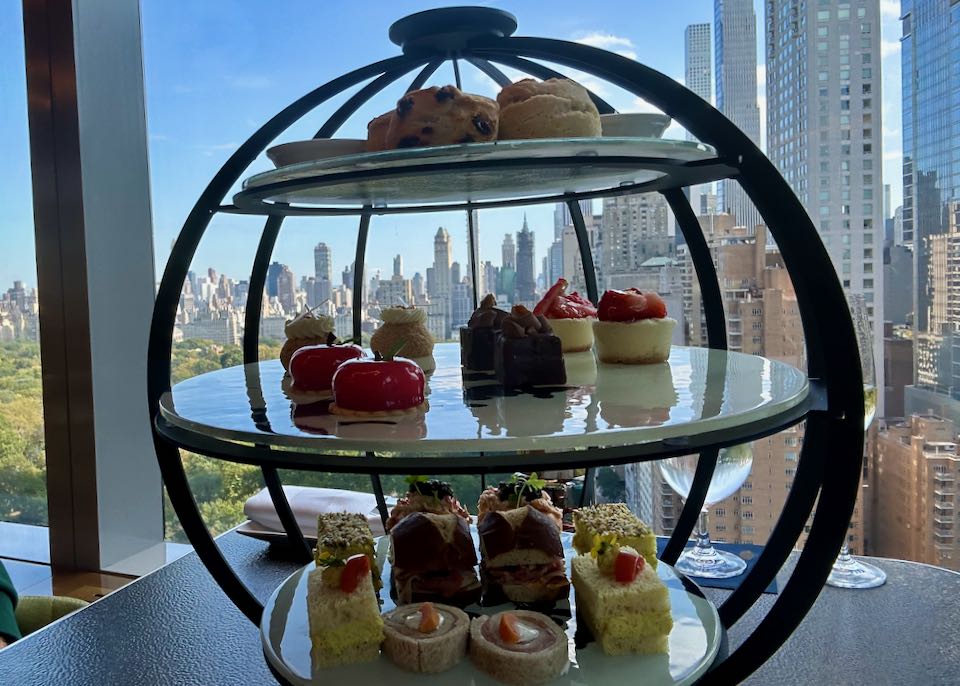
Afternoon tea at MO Lounge in the Mandarin Oriental is an absolute delight.
- Best Hotels on the Upper West Side
Hotel Beacon • Hotel phone: +1 (212) 787-1100
Mandarin Oriental • Hotel phone: +1 (212) 805-8800
The Wallace • Hotel phone: +1 (212) 362-1006- Best Cheap/Midrange Hotels
Fairfield Inn & Suites Manhattan/Central Park • Hotel phone: +1 (212) 757-8550
Lucerne Hotel • Hotel phone: +1 (212) 875-1000- Best Hostels
HI NYC • Hotel phone: +1 (212) 932-2300
Kama Central Park • Hotel phone: +1 (646) 438-9222
International Student Center • Hotel phone: +1 (212) 787-77063. Upper East Side
Some of the city’s wealthiest residences are found in this tranquil area roughly between 59th and 96th streets, east of Fifth Avenue and Central Park. It is home to “Museum Mile,” comprising several excellent art institutions along Fifth Avenue, including the world-famous Metropolitan Museum of Art, the Frick Collection (based at the Frick Madison in the Breuer Building until at least the end of 2023), and the iconic Guggenheim Museum designed by Frank Lloyd Wright. Other highlights include the Neue Galerie, dedicated to early 20th-century art from Austria and Germany (which owns the “Woman in Gold”, aka Gustav Klimt’s Portrait of Adele Bloch-Bauer), the absorbing Cooper Hewitt Smithsonian Design Museum, and the huge Jewish Museum, containing the largest collection of Judaica outside Israel. The neighborhood is bordered by two green oases, Central Park to the west and Carl Schurz Park to the east, which features a promenade along the East River and Gracie Mansion, the official residence of the mayor of New York City since 1942.
Restaurants abound on the Upper East Side, from neighborhood diners to fine dining, but hotels are on the expensive side.
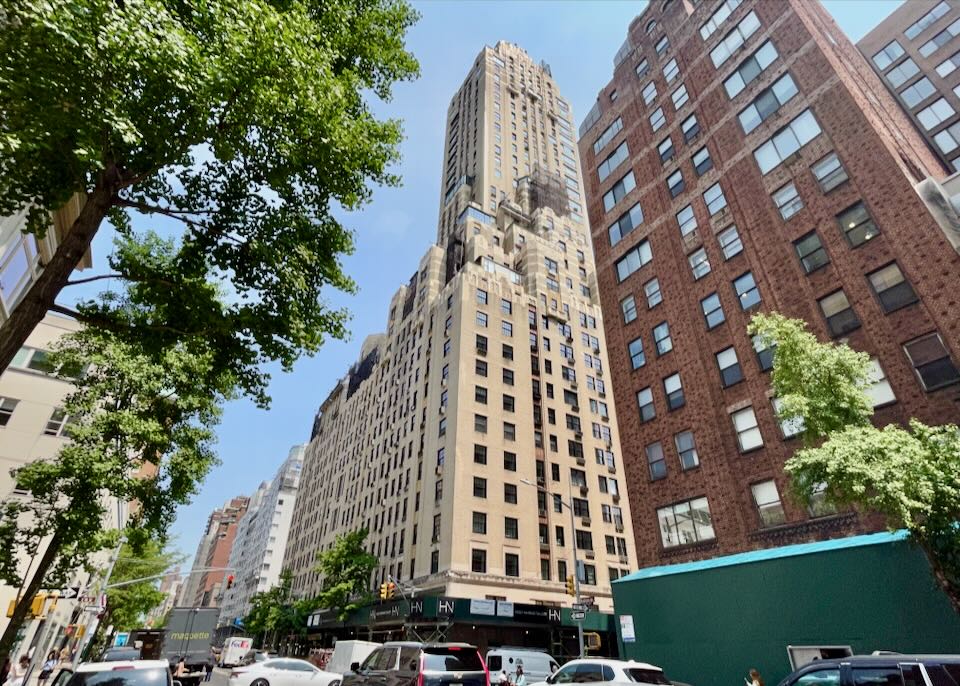
The Carlyle Hotel on New York’s Upper East Side
- Best Hotels on the Upper East Side
Lowell Hotel • Hotel phone: +1 (212) 838-1400
The Mark • Hotel phone: +1 (212) 744-4300
The Pierre • Hotel phone: +1 (212) 838-8000
The Sherry-Netherland • Hotel phone: +1 (212) 355-2800
The Carlyle • Hotel phone: +1 (212) 744-16004. Tribeca and SoHo
Named for their geography (“Triangle Below Canal”, and “South of Houston”), these former warehouse neighborhoods have seen a rebirth in recent years. Thanks largely to resident Robert DeNiro, Tribeca is home to the noted film festival of the same name, and its spacious, pricey loft apartments and fine dining attract the rich and famous. Soho’s loft spaces first drew artists and galleries, but rising rents have changed the area into a trendy shopping and dining district. Most people come here to shop, drink or eat, but there are a few attractions to check out, as well.
Tribeca’s tallest skyscraper, 56 Leonard, is quite a sight, nicknamed the “Jenga Building” thanks to its cantilevered glass box structure. Just across Canal Street is the recently opened Jackie Robinson Museum, commemorating the famous African American baseball player. A bit further north is the New York City Fire Museum, dedicated to the New York Fire Department since its creation in the 19th century, while the nearby Color Factory is one of the city’s burgeoning “Instagram” museums, chock full of sensory and immersive experiences (over in SoHo proper there’s also the Museum of Ice Cream, with the world’s largest “Sprinkle Pool”.) Fans of sweet treats should join the line outside Dominique Ansel Bakery to sample the still wildly popular cronut (the donut/croissant hybrid).
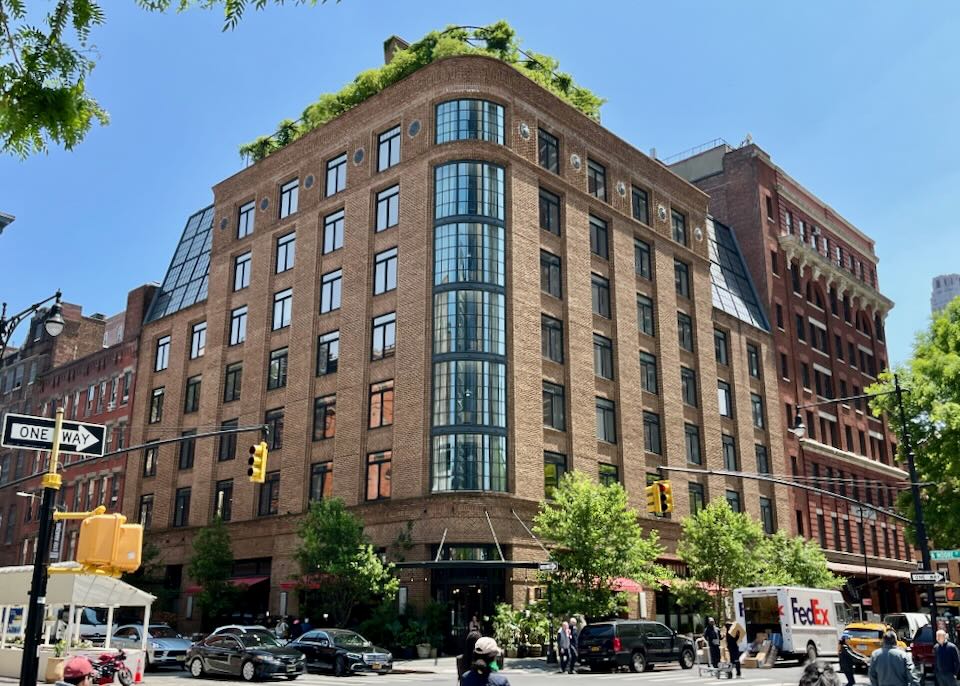
The excellent Greenwich Hotel in Tribeca
- Best Hotels in Tribeca and SoHo
Barrière Fouquet’s New York • Hotel phone: +1 (917) 965-2600
The Broome • Hotel phone: +1 (212) 431-2929
Crosby Street Hotel • Hotel phone: +1 (212) 226-6400
The Greenwich Hotel • Hotel phone: +1 (212) 941-8900
ModernHaus SoHo • Hotel phone: +1 (212) 465-2000
The Roxy Hotel • Hotel phone: +1 (212) 519-6600
Soho Grand Hotel • Hotel phone: +1 (212) 965-3000- Best Midrange Hotels
Best Western Plus Soho • Hotel phone: +1 (646) 398-9909
Courtyard Manhattan/SoHo • Hotel phone: +1 (212) 414-82825. East Village
This partly gentrifying, one-time hippie haven from Houston to 14th Streets east of Third Avenue still offers many affordable restaurants, but new development near Houston and the neighboring Bowery have brought avant garde galleries, more upscale dining, and slick hotels. It’s still one of the city’s hippest neighborhoods, though, flooded with diners and a diverse party crowd at the weekends, especially students at NYU (many of whom live here). Make for Tompkins Square Park on a summer afternoon to soak up the vibe, grab a beer at McSorley’s Old Ale House (America’s oldest pub), or take in a poetry slam at Nuyorican Poets Cafe. New York’s Ukrainian community is represented by St George Ukrainian Catholic Church, the Ukrainian Museum, and restaurants like Streecha Ukrainian Kitchen and local favorite Veselka.
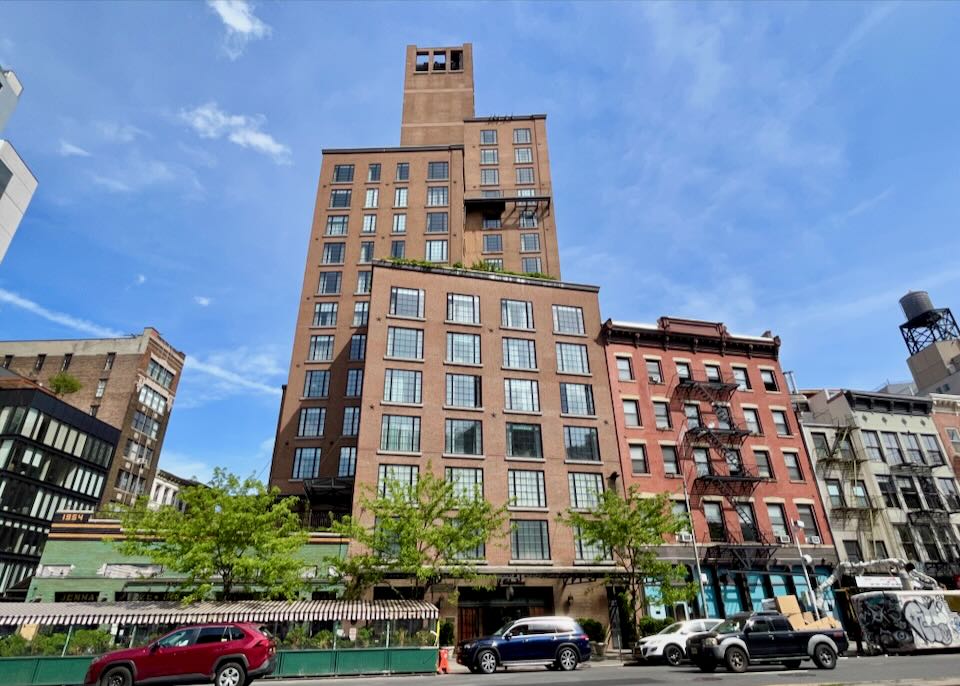
The Bowery is one of the best of the East Village’s few hotel options.
- Best Hotels in the East Village
The Bowery Hotel • Hotel phone: +1 (212) 505-9100
The Standard East Village • Hotel phone: +1 (212) 475-57006. Greenwich Village (aka West Village) and the Meatpacking District
No grid plan here, just a crazy maze of leafy lanes lined with charming 19th-century townhouses, many of which once housed famous artists, writers, and musicians. The cafes, clubs and coffeehouses of “the village” as the locals know it, have long been magnets for for a youthful crowd. This group includes students from New York University, a renowned institution that spans many blocks around Washington Square Park. The park itself is recognized as one of New York City’s most lively and active green spaces; its Washington Memorial Arch, built in 1892 by Stanford White, is always a hub of activity at the weekends.
In the northwest corner is the Meatpacking District. Once home to wholesale meat packers and desolate at night, the cobbled streets west of 9th Avenue near 14th Street have become one of the city’s liveliest centers for dining and clubbing. Two art museums worth a visit include the Whitney Museum of American Art, located at the southern end of The High Line, and the Museum of Illusions, an “Instagram museum” of wildly photogenic optical illusions.
Small groups of excited fans still congregate at the junction of Bedford and Grove Streets to see the exterior of Monica’s apartment from the hit 90’s TV show Friends, and “Carrie Bradshaw’s Apartment” at 66 Perry Street (featured in Sex and the City). The iconic LGBT venue The Stonewall Inn is America’s first National Monument dedicated to the LGBTQ-rights movement (which was sparked by riots that took place here in 1969), and will eventually feature a visitors’ center – the Gay Liberation Monument and new NY City AIDS Memorial are nearby.
Otherwise, West Village is mainly about eating, drinking, and live entertainment: cappuccino at historic Caffe Reggio; toasted sandwiches at Murray’s Cheese Shop; cupcakes at Magnolia Bakery; beers at the White Horse Tavern, where Dylan Thomas had his last drink; live jazz at the Village Vanguard; and laugh-out-loud jokes at the Comedy Cellar.
Like the East Village, this is a great area to visit, but with few hotel options.
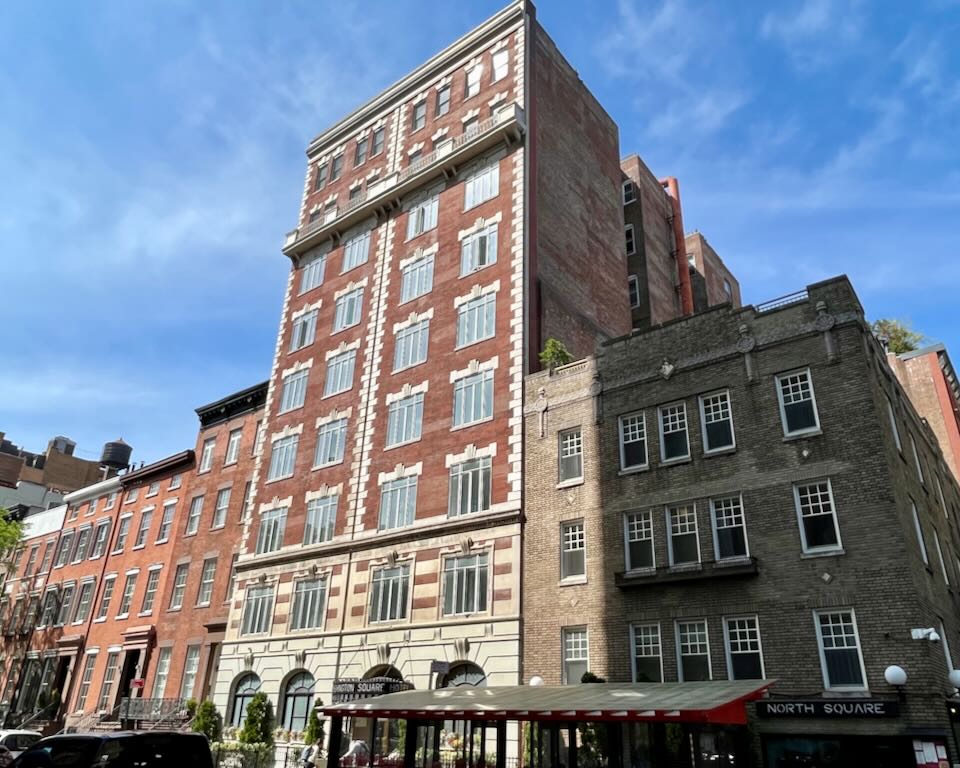
The historic Washington Square Hotel is ideally located for enjoying the bars and entertainment venues of the West Village.
- Best Hotels in Greenwich Village (West Village) and the Meatpacking District:
The Marlton Hotel • Hotel phone: +1 (212) 321-0100
Walker Hotel Greenwich Village • Hotel phone: +1 (212) 375-1300
Washington Square Hotel • Hotel phone: +1 (212) 777-9515
The Standard High Line • Hotel phone: +1 (212) 645-46467. Chelsea
Further north, from 22nd to 28th streets, the old warehouses of Chelsea now house dozens of art galleries. The area has blossomed in recent years, with swanky new hotels since the opening of the High Line, an elevated pedestrian park on a former rail line running from 13th to 34th streets. The Standard High Line Hotel is located directly atop the High Line.
Nearby, jutting out into the Hudson River, Little Island public park is one of the city’s newer attractions, its unique design featuring “tulip pot” concrete piles. Other highlights in the area include Chelsea Market, with its assortment of food stores and restaurants, the Rubin Museum of Art, specializing in paintings, sculptures, and textiles from Nepal and Tibet. Google has its New York HQ here, with a large retail store opposite Chelsea Market.
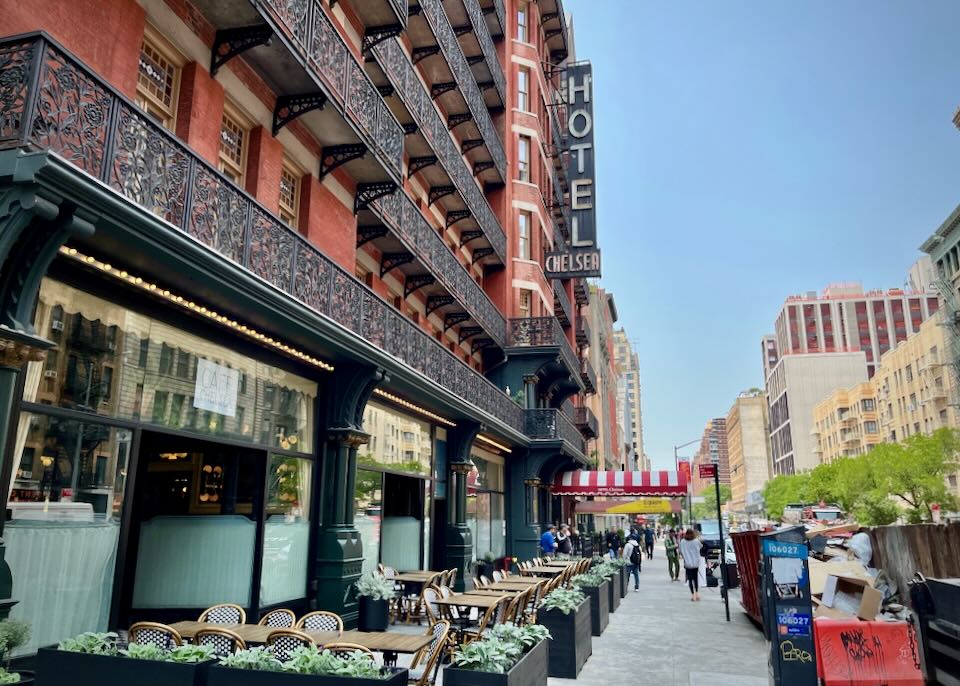
The iconic Hotel Chelsea is the historic stomping ground of forward-thinking celebrities ranging from Mark Twain to Janis Joplin to Robert Mapplethorpe.
- Best Hotels in Chelsea
The Hotel Chelsea • Hotel phone: +1 (212) 483-1010
The Maritime Hotel • Hotel phone: +1 (212) 242-4300
The Moore • Hotel phone: +1 (212) 255-5400
Motto Chelsea • Hotel phone: +1 (212) 668-8624
The High Line Hotel • Hotel phone: +1 (212) 929-3888- Best Cheap/Midrange Hotels
Cambria Chelsea • Hotel phone: +1 (212) 244-4477
The Leo House • Hotel phone: +1 (212) 929-1010- Best Hostel
Chelsea International • Hotel phone: +1 (212) 647-00108. Lower Manhattan and the Financial District
Its narrow twisting streets are evidence that this is the oldest part of the city, though today Wall Street and its surroundings are home to a forest of skyscrapers that dwarf the few remaining historic sites. With the completion of the new One World Trade Center (which features a sky-high observation deck) and the 9/11 Memorial and Museum, this area is booming with tourists and new shops, hotels, and restaurants.
You can learn about the lives of enslaved Africans in Colonial New York at the African Burial Ground Monument, eat outside at the restaurants along historic Stone Street, shop underneath Santiago Calatrava’s bizarre, dinosaur skeleton-like Oculus, see Alexander Hamilton’s grave at Trinity Church, or soak up the history at St Paul’s Chapel, the oldest church in Manhattan. The famous Charging Bull statue, iconic symbol of Wall Street, is often mobbed by tourist crowds (it actually stands on Broadway, just north of Bowling Green), while the Fearless Girl statue now stares down the front of the New York Stock Exchange on Broad Street.
Bowling Green is home to Smithsonian’s National Museum of the American Indian, while nearby Battery Park is launching point for ferries to the Statue of Liberty and Ellis Island. On the north side of the park, the Museum of Jewish Heritage is a poignant memorial to the Holocaust.
Over on the East River, the 1820s row houses of the Seaport District and old sailing ships of the South Street Seaport Museum have been joined by revamped mall Pier 17 and the Tin Building, a posh food market by Chef Jean-Georges Vongerichten. Newly open in 2022, the Hall des Lumières serves as a spectacular immersive exhibit center on the edge of the Financial District (near City Hall and the wedding cake Manhattan Municipal Building), with themes that range from Gustav Klimt to space exploration.
The only way to reach Liberty, Ellis or Governors islands is by ferry from the foot of Manhattan (Battery Park). This is also where you catch the free Staten Island Ferry. Many Financial District hotels have good rates on weekends when business travelers go home, otherwise it tends to be pricey down here.
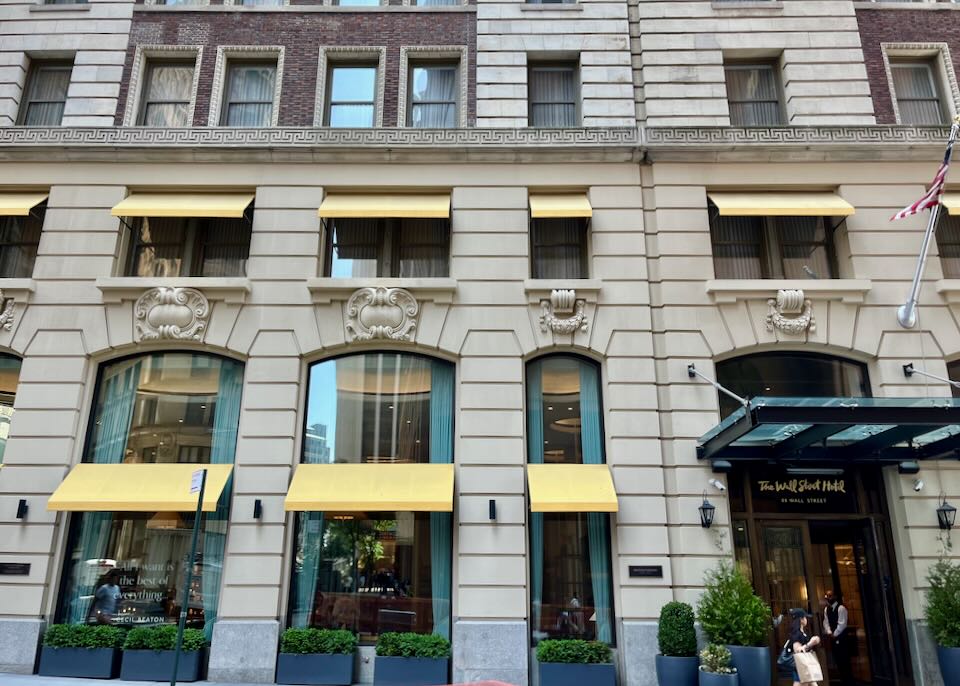
The 5-star Wall Street Hotel
- Best Hotels in Lower Manhattan and the Financial District
The Beekman • Hotel phone: +1 (212) 233-2300
Casa Cipriani New York • Hotel phone: +1 (212) 584-5801
Conrad Downtown • Hotel phone: +1 (212) 945-0100
Four Seasons Downtown • Hotel phone: +1 (646) 880-1999
Mint House at 70 Pine • Hotel phone: +1 (646) 598-0100
Wall Street Hotel • Hotel phone: +1 (212) 688-9255- Best Midrange Hotels
AC Hotel Downtown • Hotel phone: +1 (212) 742-1900
Artezen Hotel • Hotel phone: +1 (212) 566-5511
Hilton Garden Inn Financial Center/Downtown • Hotel phone: +1 (212) 248-1100
Hotel Indigo Downtown-Wall Street • Hotel phone: +1 (646) 869-6700
Wall Street Inn • Hotel phone: +1 (212) 747-15009. Lower East Side (including Nolita, Chinatown, and Little Italy)
The old ethnic neighborhoods of the city are changing. Crowded and ever-fascinating, Chinatown has mushroomed, taken over all but one street of what was Little Italy and rapidly absorbing much of the Jewish Lower East Side. However, on Orchard Street and blocks closer to Houston bordering the East Village, the area has been rediscovered by a new generation, and cool shops, clubs, and restaurants are blooming. The Tenement Museum is the best evidence of what used to be, and some Jewish culinary landmarks remain on Houston Street; legendary Katz’s Deli, Russ & Daughters, and knish-maker Yonah Schimmel. What’s left of Little Italy clusters along Mulberry Street, mostly red sauce restaurants and bakeries, though the Italian American Museum is a good place to learn about the history of the area.
The blocks around St Patrick’s Old Cathedral are known as Nolita (“North of Little Italy”), one of the hippest parts of the city, home to fashion boutiques and cool restaurants, as well as the stylish New Museum of Contemporary Art over on the Bowery. You can learn about Chinese American history at the Museum of Chinese in America before wandering Chinatown’s main drag, Mott Street, packed with restaurants, souvenir stalls, Chinese bakeries, and tea shops. The Museum at Eldridge Street, a fully restored, working synagogue, offers a glimpse of the Jewish Lower East Side at its heyday, while the future is represented by Essex Crossing, a huge mixed-use development at the intersection of Delancey and Essex streets that includes Essex Market, The Market Line mall, and the International Center of Photography museum.
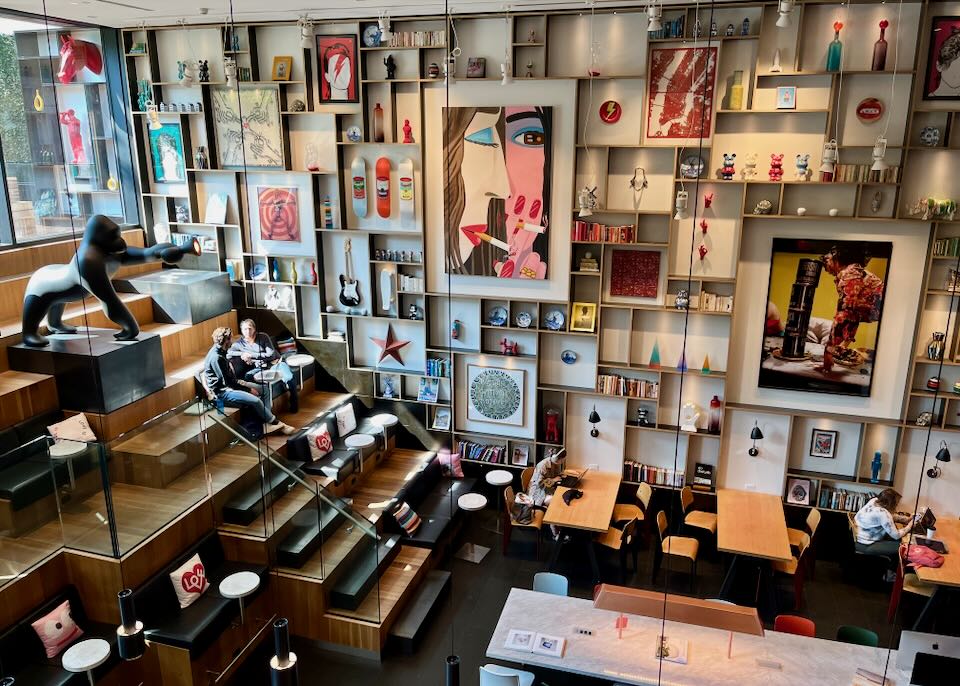
citizenM Bowery is a great midrange hotel on Nolita’s eastern edge.
- Best Hotels on the Lower East Side
Hotel 50 Bowery • Hotel phone: +1 (212) 508-8000
Ludlow Hotel • Hotel phone: +1 (212) 432-1818
Nine Orchard • Hotel phone: +1 (212) 804-9900
NobleDen Hotel • Hotel phone: +1 (212) 390-8988
Kasa Lantern Lower East Side • Hotel phone: +1 (650) 451-3444- Best Midrange Hotels
citizenM Bowery • Hotel phone: +1 (212) 372-7274
Holiday Inn Lower East Side • Hotel phone: +1 (212) 475-2500
Hotel Mimosa • Hotel phone: +1 (212) 343-424310. Brooklyn
No longer in Manhattan’s shadow, Brooklyn has emerged as a fully-fledged tourist destination in its own right; a patchwork of neighborhoods featuring gorgeous brownstones, award-winning restaurants, hip bars, craft markets, superb museums and galleries, and cutting-edge performance spaces. Brooklyn is a surprisingly large borough, and it’s best to view it as a series of separate neighborhoods connected by bus, ferry, and subway. Many of the top attractions in Brooklyn are concentrated in neighborhoods close to the East River, just across from Manhattan: the Fulton Ferry District, Dumbo (summer location of the Brooklyn Flea arts and craft market, and year-round Time Out Market New York), Brooklyn Heights, and just inland, Downtown Brooklyn itself.
But this just scratches the surface; to the south lies trendy Boerum Hill, Cobble Hill, and Carroll Gardens (collectively known as “BoCoCa”), and the old-school waterfront district of Red Hook, while further inland (encompassing the borough’s highest point) is affluent Park Slope and the green swathe of Prospect Park – major attractions such as the Brooklyn Museum and Brooklyn Botanical Gardens are here. The northern sector of Brooklyn includes Williamsburg and Greenpoint, slightly cut off from the rest of the borough but dynamic cultural and nightlife hubs of their own. Williamsburg is home to the lauded Brooklyn Brewery (which gives free tours), and Smorgasburg summer food market, as well as some of the best boutique hotels in New York (with sensational views of Manhattan).
Way off to the south, facing the Atlantic, is Coney Island, New York’s loveably vintage seaside resort. The beach is still a huge swathe of golden sand that’s usually packed in summer, and the famous wooden boardwalk is a hive of activity, anchored by Nathan’s Famous hot dogs, the iconic Luna Park amusements (such as the Coney Island Cyclone), and Deno’s Wonder Wheel.
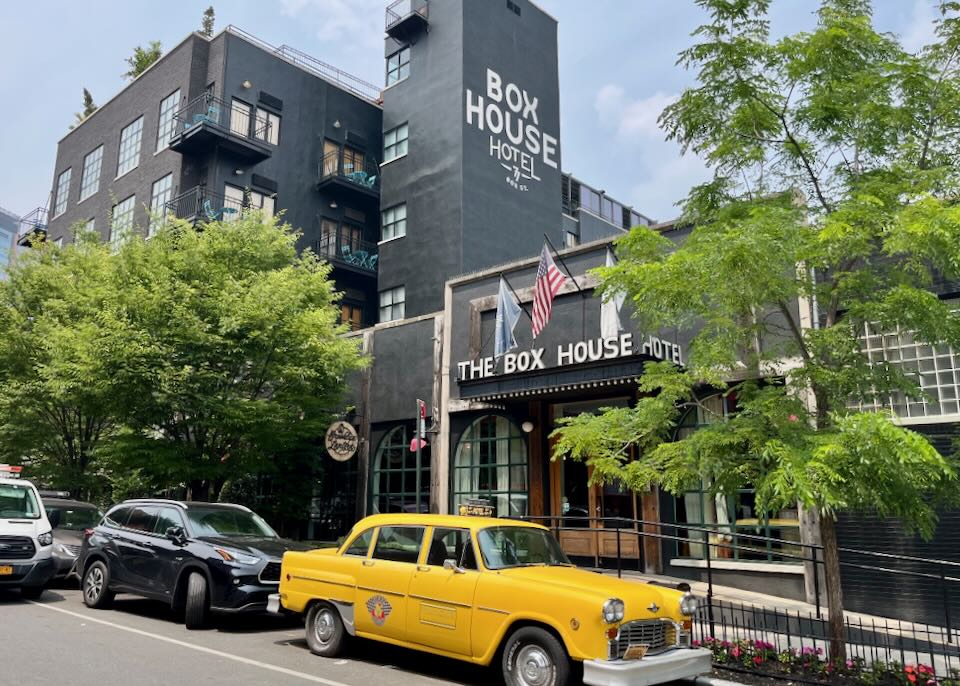
The wonderful Box House Hotel is located in Brooklyn’s Greenpoint neighborhood.
- Best Hotels in Brooklyn
1 Hotel Brooklyn Bridge • Hotel phone: +1 (833) 625-6111
Ace Hotel Brooklyn • Hotel phone: +1 (718) 313-3636
The Box House Hotel • Hotel phone: +1 (718) 383-3800
Franklin Guesthouse • Hotel phone: +1 (718) 383-3900
The Hoxton, Williamsburg • Hotel phone: +1 (718) 215-7100
Penny Williamsburg • Hotel phone: +1 (929) 594-2020
The William Vale • Hotel phone: +1 (718) 631-8400
Wythe Hotel • Hotel phone: +1 (718) 460-8000- Best B&Bs in Brooklyn
Akwaaba Mansion • Hotel phone: +1 (718) 455-5958
Rhonda’s Bed and Breakfast • Hotel phone: +1 (347) 409-2450- Best Midrange Hotels in Brooklyn
Hampton Inn Brooklyn/Downtown • Hotel phone: +1 (718) 875-8800
Moxy Brooklyn Williamsburg • Hotel phone: +1 (718) 782-6699
Pod Brooklyn Hotel • Hotel phone: +1 (844) 763-7666
Pointe Plaza Hotel • Hotel phone: +1 (718) 782-7000- Best Hostel in Brooklyn
NY Moore Hostel • Hotel phone: +1 (347) 227-8634More New York City Neighborhoods
We’ve covered our favorite neighborhoods to visit and stay in more detail above, but with more time these districts are also worth checking out:
- The Flatiron District, NoMad, & Gramercy Park: These once unexciting neighborhoods between the East and West Villages and Midtown Manhattan are now part of an up-and-coming zone of brand-new hotels, hip restaurants, and contemporary museums. The neighborhood north of Union Square is known as the Flatiron District, after the iconic triangular skyscraper on the southwest corner of Madison Square Park. Other highlights include Theodore Roosevelt’s Birthplace (the rebuilt home where the 26th president was born in 1858), The FRIENDS™ Experience (a kitsch but fun homage to the beloved TV show), Eataly NYC Flatiron (a giant Italian food emporium), and the original Shake Shack burger stall in Madison Square Park.The up-and-coming neighborhood north of here is known as NoMad, home to the family-friendly National Museum of Mathematics, adults-only Museum of Sex, and many excellent restaurants. To the east, upscale Gramercy Park features the wonderful Fotografiska Museum NYC photography gallery and the National Arts Club, which hosts temporary art exhibitions, free of charge. Our favorite hotels here are the Ritz-Carlton NoMad, New York EDITION, Hotel Giraffe, Virgin New York City, and the cheaper Flat NYC. The highly anticipated Fifth Avenue Hotel opened on October 16 (though I haven’t visited yet).
- Harlem & Washington Heights: Manhattan north of Central Park and 110th Street is dominated by Harlem, the country’s most famous African American community. Since the Harlem Renaissance of the 1920s, it’s been through several cycles of hard times, though before the COVID epidemic it was experiencing a sustained period of (controversial) gentrification and regeneration. There’s lots to see and experience here: the exhibitions at the Schomburg Center for Research in Black Culture, soul food at Marcus Samuelsson’s Red Rooster or iconic Sylvia’s, the revamped Studio Museum, the Museo del Barrio for Puerto Rican and Latino culture and art, the Africa Center for art exhibitions highlighting contemporary Africa and its diaspora; and the Abyssinian Baptist Church with its incredible Gospel choir on Sunday.Further north, Washington Heights is New York’s Little Dominican Republic. Highlights up here include Hamilton Grange National Memorial, last home of founding father Alexander Hamilton; the newly renovated Hispanic Society Museum; the colonial Morris-Jumel Mansion; and the wonderful Cloisters Museum, home to the Met’s collection of medieval tapestries, paintings, and sculpture. Our favorite hotels up here are Aloft Harlem, Mount Morris House, and the brand-new Renaissance New York Harlem Hotel.
- Queens: Most visitors’ only experience of Queens is the airport, but there’s lots to see and do here, especially if this is your second or third visit to New York. For New Yorkers, Queens is synonymous with food – you can sample just about every cuisine on earth in this multi-cultural borough, with authentic diners offering much cheaper prices than Manhattan. In terms of sights, there’s the contemporary art center MoMA PS1, Noguchi Museum, and Museum of the Moving Image in Long Island City/Astoria, close to Midtown, as well as some of the city’s best craft breweries.Farther out, Flushing Meadows Corona Park encompasses Citi Field (home of the New York Mets baseball team), the USTA Billie Jean King National Tennis Center (home of the US Open Tennis Championships), the Queens Museum, Queens Zoo, and New York Hall of Science. Jazz fans should make a pilgrimage to the Louis Armstrong House Museum, the jazz legend’s home between 1943 and his death in 1971.Our favorite hotels in Queens include Aloft Long Island City, Home2 Suites, LIC Hotel, The Local NY, and The Modernist Hotel in Long Island City, a short subway ride from Midtown Manhattan.
- The Bronx: Parts of the South Bronx remain sketchy, but a visit to Yankee Stadium to see the New York Yankees play baseball is a classic New York experience. Elsewhere you’ll be surprised at just how diverse the Bronx is, and how much there is to see: the authentic Little Italy section of Belmont, the Bronx Zoo, and the New York Botanical Garden make for an excellent (and perfectly safe) day out. With more time you could explore the historic Wave Hill estate, Woodlawn Cemetery (tranquil resting place of many famous New Yorkers), Van Cortlandt Park, or the fish shacks on City Island. The Bronx is an easy day trip from Manhattan, but if you’d like to stay over to soak up the vibe, the best hotels in the South Bronx are Opera House Hotel and Wingate Bronx/Haven Park.
Getting Into and Around New York
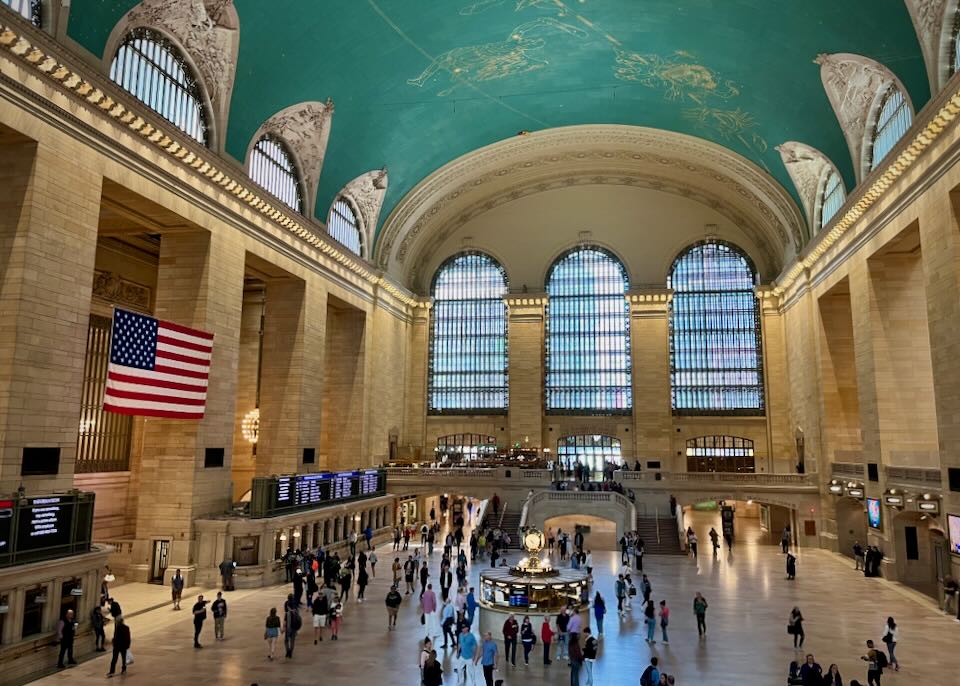
New York’s Grand Central Station
Learning the transit system is not difficult since much of central Manhattan is laid out on a grid with cross streets clearly numbered.
- If numbers go up, they are leading north or uptown, descending numbers head south or downtown. Most of the avenues are one-way, so buses generally travel in only one direction; major two-way arteries like 14th, 34th, 42nd, and 57th streets have buses going in both directions. (Route maps are posted at every stop).
- Subway stations are labeled either uptown or downtown to show the direction of the trains on that track. “Crosstown” literally means going across the city from east to west. Fifth Avenue is the dividing line between what New Yorkers call “east side” and “west side” in Manhattan. A subway shuttle train crosses the city on 42nd Street from Grand Central Terminal to Times Square.
- To calculate distances, 20 blocks in Manhattan equals roughly one mile. For example, Midtown between 34th and 59th streets, where many famous sights are found, is less than 1.5 miles long and easily walkable. The winding lanes in the older parts of the city also are quite walkable, but in these areas, street maps or mobile phone maps are recommended to guide your way.
Hotels within steps of NYC subway station: Sheraton Times Square • citizenM Times Square • Smyth Tribeca • The New Yorker • Courtyard Times Square • The Knickerbocker • Mandarin Oriental • The Sherry Netherland • Equinox • Hotel Indigo Financial District
Getting into Manhattan from the Airport
Don’t rent a car. It’s not a good idea to drive in New York at all, either in your own car or in a rental. Roads are often congested, and parking is ludicrously expensive. Many of the tunnels and bridges into Manhattan have hefty tolls.
Public transport (subway, buses) is cheap and efficient in New York, and it’s surprisingly easy to simply walk between major sights. Taxis and Uber/Lyft cars are also readily available. Taxis are still the best option for those with lots of luggage or arriving late/early. Look for the yellow “taxi” signs exiting the terminal and follow the official lines – ignore the touts, they are likely to overcharge. Uber and Lyft offer slightly cheaper rates than regular taxis from the airports, though the pickup areas are different – look for signs or ask an official.
If arriving on the eve of a major public holiday, or very late at night, booking a car service in advance (like Welcome Pickups can save time, but there are usually plenty of yellow cabs and Uber cars available 24hrs.
How to get to Manhattan from Newark Airport
Newark Liberty International Airport is across the Hudson River in New Jersey, around 14 miles southwest of Times Square.
• Newark Airport Express runs to Grand Central Station, Port Authority Bus Terminal and Bryant Park (one block east of Times Square) every 20 to 45 minutes daily between 4am and 1am. The journey takes around 50 minutes depending on traffic. The one-way fare is $18.70.
• Go Airport Shuttle runs shared minibus services to hotels in Manhattan (starting at around $45to Midtown), but this must be reserved in advance and times must be flexible.
• By train: All the Newark Airport terminals are connected by the AirTrain to the nearby Newark Liberty International Airport Train Station. Once at the station you can take frequent NJ Transit trains heading into Manhattan (30 minutes to Penn Station) for $15.50. The AirTrain runs 24 hours (every 3–15 minutes) and costs $8, but this is included when buying a NJ Transit ticket from machines in the AirTrain terminals or at the main station – there’s no need to pay separately for the AirTrain. Don’t get off at Newark Penn Station, the first stop after the airport!
• Taxis from Newark into Manhattan charge around $55 to $75 metered fare, plus $1.25 Airport Access Fee (pick-ups only), round-trip bridge and tunnel tolls and gratuity. It’s possible to ask the driver to avoid toll roads in New Jersey, but to get to Manhattan the taxi will need to take the Lincoln or Holland toll tunnels. Reckon on spending around $85–100 to most hotels in Midtown Manhattan (allow 45 to 60 minutes).
How to get to Manhattan from JFK
JFK International Airport is located in Queens, around 14 miles southeast of Times Square in Manhattan.
• Go Airport Shuttle offers shared minibus services direct to hotels (from around $46 to Midtown Manhattan), but these must be reserved in advance and times must be flexible.
• By train/subway: The cheapest way into the city. Take the AirTrain from the terminal to the Jamaica or Howard Beach stations in Queens. A charge of $8 is payable when exiting the AirTrain. From either station it’s just $2.75 into the city on the subway: E, J, Z from Jamaica, and A from Howard Beach. Travel time to Manhattan is usually around one hour. From Jamaica there is also the option of taking the faster LIRR (Long Island Rail Road) to Penn Station ($7.75 off-peak, $10.75 peak; 19–21 minutes); buy tickets at Jamaica station, as fares are much more expensive if purchased on board the train.
• Taxis charge a flat rate of $70 to anywhere in Manhattan from JFK (plus a 50-cent MTA state surcharge, a $1 improvement surcharge, a $5 rush-hour surcharge 4 to 8pm weekdays except legal holidays, a New York State Congestion Surcharge of $2.50, bridge and tunnel tolls, and a tip of 10–20 percent). Tolls are extra, but there are no mandatory tolls between JFK and Manhattan – the bridges across the East River are free. However, tolls are payable using the Queens-Midtown Tunnel, which can sometimes be faster to Midtown hotels. If time is not an issue, insist that the driver takes a “free” bridge to avoid the toll (the same goes for Uber/Lyft drivers).
How to get to Manhattan from LaGuardia
LaGuardia Airport is in northern Queens, around 8 miles northeast of Times Square.
• Go Airport Shuttle offers shared minibus services to hotels (from around $40 to Midtown Manhattan), but these must be reserved in advance.
• City bus: LaGuardia is not connected to the subway system, so the cheapest way into the city is to take a local bus. The Q70 LaGuardia Link(which is free)runs every 10 minutes (24hrs) to subway stations at Woodside (#7 plus LIRR services) and Jackson Heights (#7, E, F, M, R) in Queens, while the M60 bus runs into northern Manhattan (every 7–30 minutes, 24hrs), along 125th Street (for #2, #3, #4, #5, #6, A,B, C, D subway lines) and down Broadway to West 106th Street.
• Taxis from LaGuardia use the meter and are usually good value; reckon on $35–45 into Manhattan plus tip and surcharges (Mon–Fri 4–8pm $1 or daily 8pm–6am 50 cents; NY State tax of 50 cents added to all trips; $1.25 Airport Access Fee for pick-ups only; 50 cent MTA state surcharge, plus a 30 cent improvement surcharge). Tolls are also extra, but it’s possible to avoid the Midtown Tunnel (see above).
New York Airport Hotels
There’s not much point in staying at the airports, but if you do need to stay here (for a very early flight, for example), the best hotel at JFK isthe conveniently located (and extremely atmospheric) TWA Hotel, within walking distance of the terminals, while the Residence Inn is the best value of the hotels just outside the airport. For LaGuardia, Aloft is a solid choice, while The Marriott is the only hotel inside Newark Airport. You’ll find all the usual chain motels and hotels just outside the airport on the highway, though nothing really stands out.
NYC Travel Tips
- New York City is served by John F. Kennedy International Airport (JFK) and LaGuardia Airport (LGA), both in Queens, and Newark Liberty International Airport (EWR) in neighboring New Jersey. LaGuardia mainly serves domestic destinations, plus some Canadian cities. Taking local city buses, trains, or subways from the airports is the cheapest way into Manhattan, but this is not recommended for those with heavy luggage or for first-time visitors. See “Getting Into and Around New York,” below.
- There are a bewildering number of New York City discount cards available, but these are only a good investment if you intend to visit a lot of sights. The longer the pass is valid, the more you’ll usually get out of it, but the only way to be sure is to examine each one and do the math. The main cards are: New York CityPASS, Go City New York Explorer Pass, The New York Pass, The New York Sightseeing Pass, and New York C3 by CityPASS.
- Free wi-fi is available at all 3 New York airports, and at cafés and museums throughout the city itself.
- Cycling is a popular form of transportation in New York, with most streets enhanced with bike lanes, and dedicated cycle paths running along the waterfront and in most parks. New York’s official bike share scheme is Citi Bike. A credit card is required to access the bikes at docking stations throughout the city – check the website for full details. Though cycling along the Hudson River and around Central Park can be a lot of fun, we don’t advise first-time visitors to travel the city streets by bike – traffic can be heavy and tough to handle for inexperienced riders.
The Best Hotels in New York City
1. Mandarin Oriental – Upper West Side
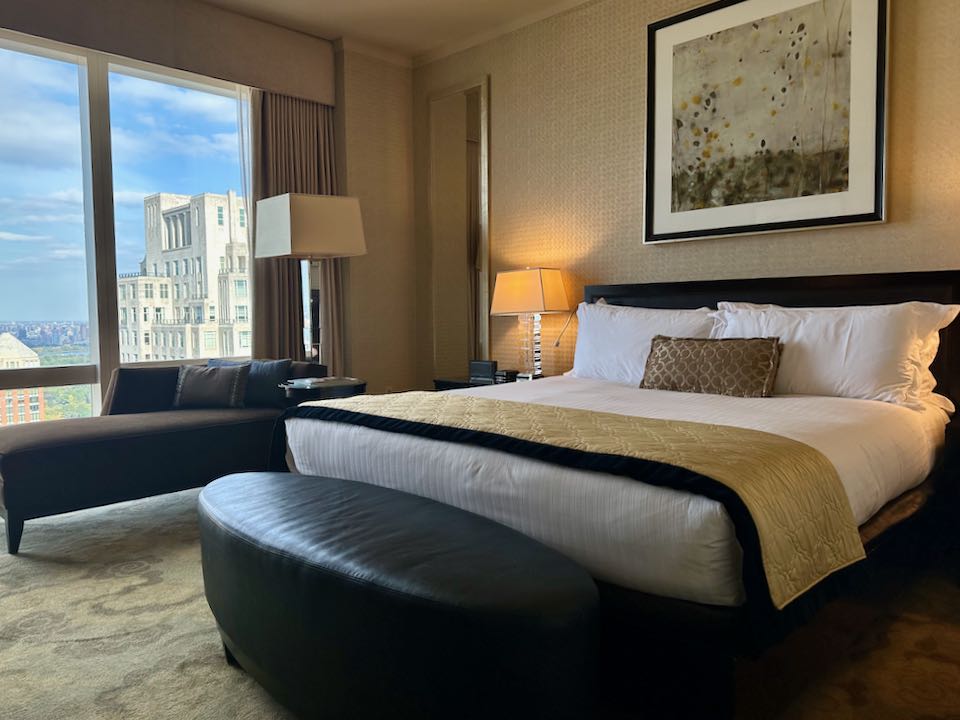
Hotel phone: 212-805-8800
Gorgeous five-star hotel nestled in the heart of Manhattan, the Mandarin Oriental offers a sublime escape amid the city’s bustling energy. With Central Park at its doorstep, this luxury sanctuary boasts 244 chic rooms, marrying contemporary elegance with Asian-inspired touches. Hudson River, Manhattan, or Central Park (recommended) views. There’s a nice pool and huge and luxurious spa. Lobby is on 35th floor. The last time I stayed here I did the afternoon tea, highly recommended.
Check Prices on Booking.com
2. The Pierre – Upper East Side
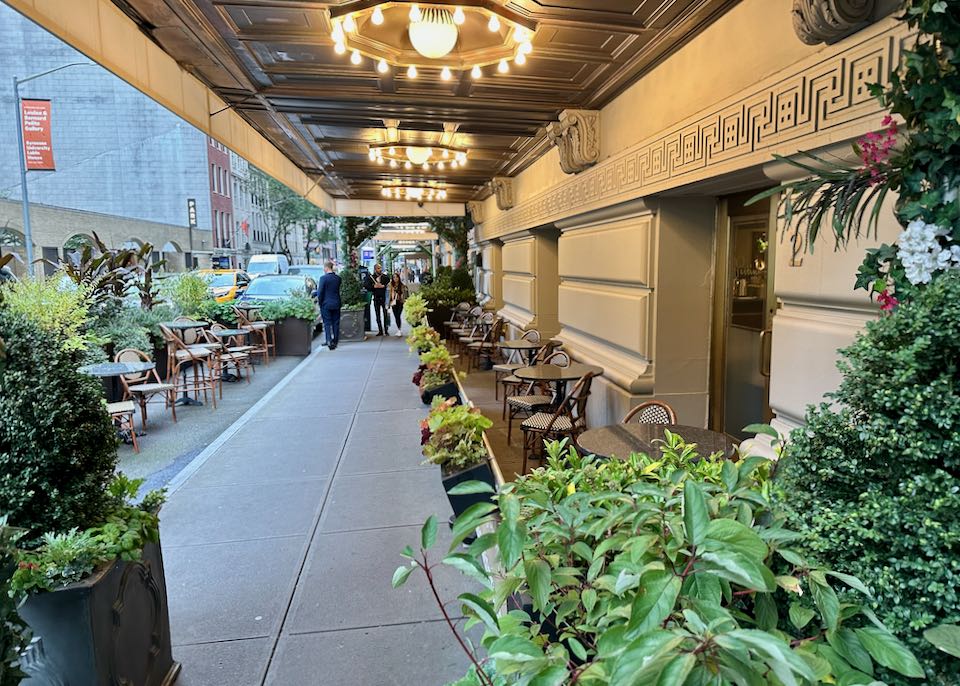
Hotel phone: 212-838-8000
A New York City landmark, The Pierre Hotel gracefully presides over the edge of Central Park, exuding an air of timeless elegance. With 189 lavish guest rooms and suites, the hotel is a testament to classic charm and contemporary luxury. The iconic Perrine restaurant and the delightful Two E Bar & Lounge invite guests to indulge in exceptional cuisine and sumptuous afternoon teas. Steeped in history, The Pierre has played host to numerous luminaries and unforgettable events, earning its storied reputation. Walking distance from Fifth Avenue’s luxury shopping and Manhattan’s finest cultural institutions, this sophisticated gem stands as a quintessential embodiment of the New York City experience.
Check Prices on Booking.com
3. Library Hotel – Midtown East
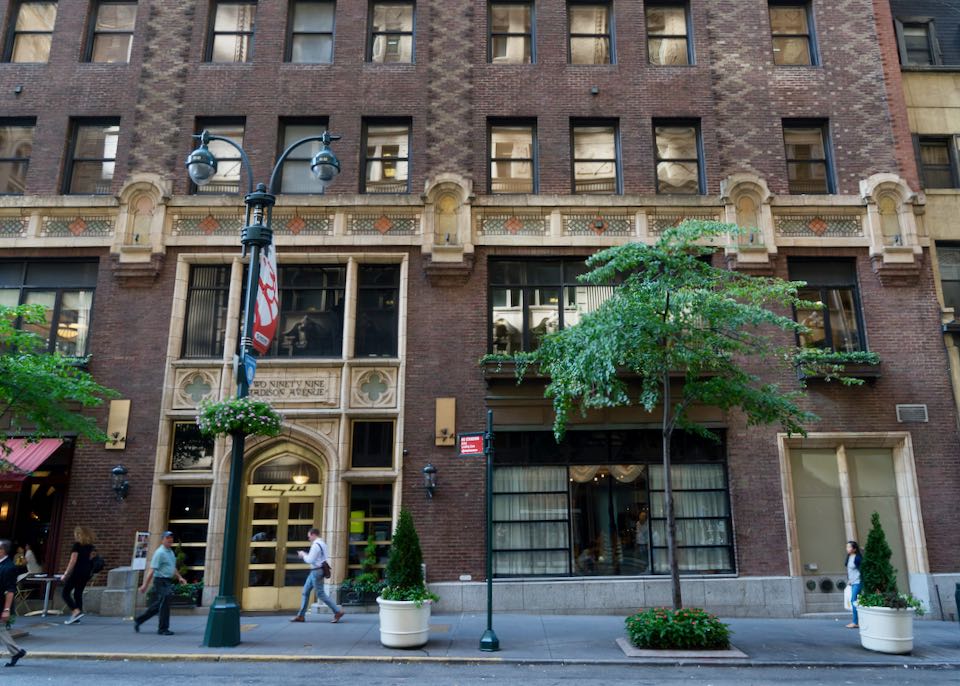
Hotel Phone: 212 983 4500
Just around the corner from the Grand Central Station, this library-themed boutique hotel (floors devoted to Math & Science, Arts, Technology – 10 categories in all) has intimate (i.e. not huge), well-appointed rooms with specialized art & libraries (related to the floor: mythology room on the religion floor with mythical art/books), mini-fridges, and city views. Suites add sitting areas and sofa beds. Has a ‘Love’ room which features the hotel’s only private terrace. Excellent value for the level of luxury – continental breakfast, refreshments and evening wine & cheese receptions, all complimentary. Great rooftop bar. I stayed here on my last visit to New York and loved it.
Check Prices on Booking.com
4. The Peninsula New York – Midtown West
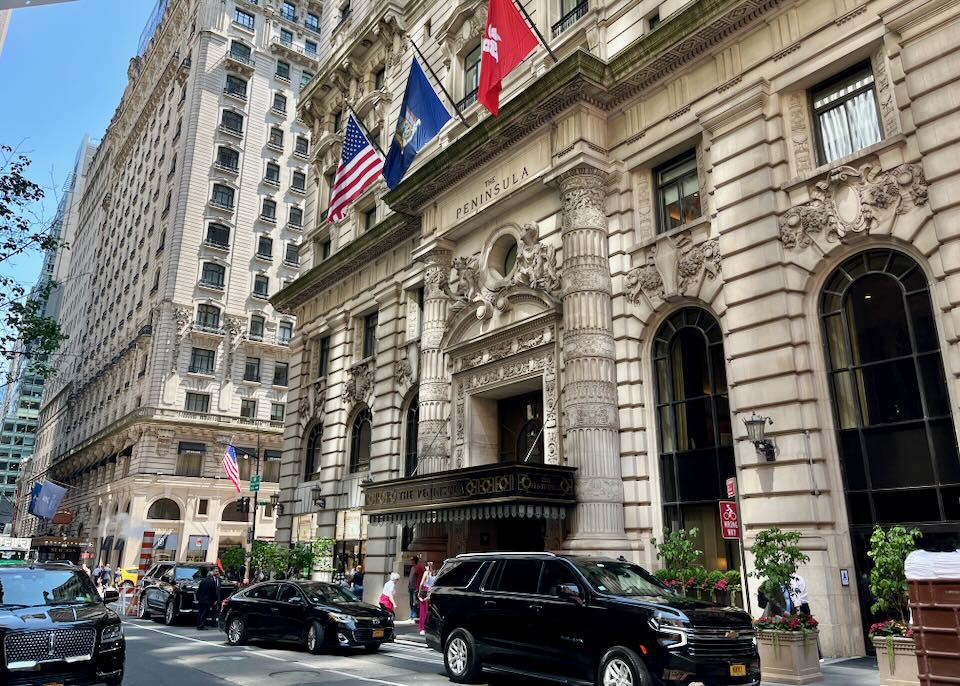
Hotel Phone: 212 956 2888
Landmark hotel (1905) with classically-styled, comfortable rooms and suites with oversized work desks, sunken tubs with TVs and courtyard/city views. Suites add living rooms, sofa beds, dressing areas, oversized walk-in closets, powder rooms, decorative fireplaces, dining rooms, gourmet kitchens, and private studies, depending on the category. City-view rooms are much brighter and better than courtyard-view rooms.
Check Prices on Booking.com
5. Crosby Street Hotel – SoHo
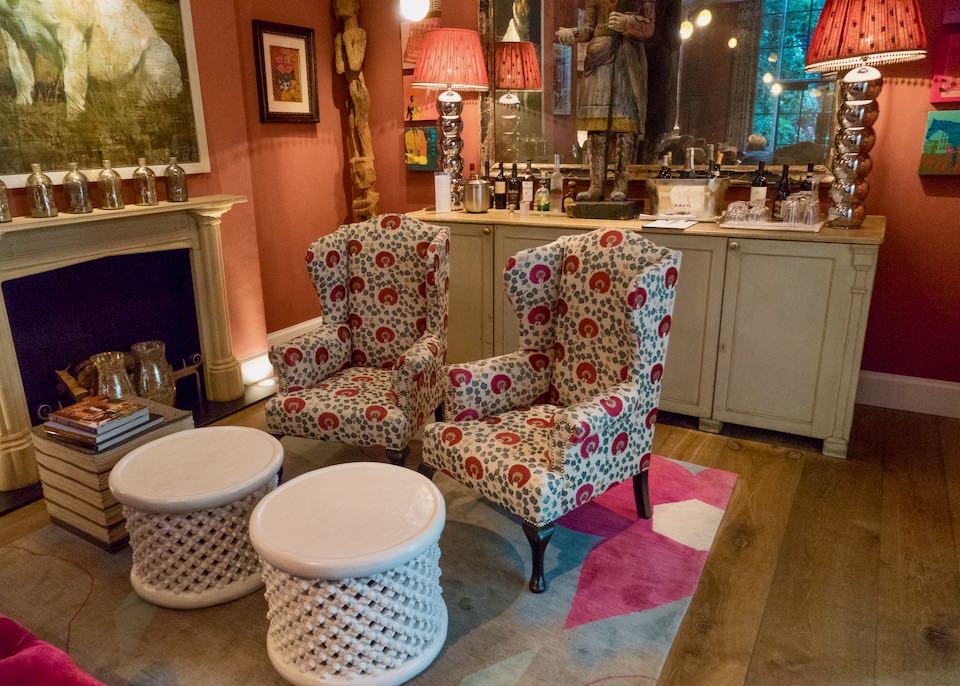
Hotel Phone: 212 226 6400
Refined Kemp-designed boutique hotel in the heart of Soho, with fresh, spacious rooms and suites having colorful designer headboards, high ceilings, full-length windows, Bluetooth Bose units, marble bathrooms and lower Manhattan/garden views. Suites add sitting areas, living & dining areas, deep bathtubs, bespoke mini-bars depending on the class. The two-bedroom Crosby Suite is fantastic.
Check Prices on Booking.com
6. The Langham – Midtown West
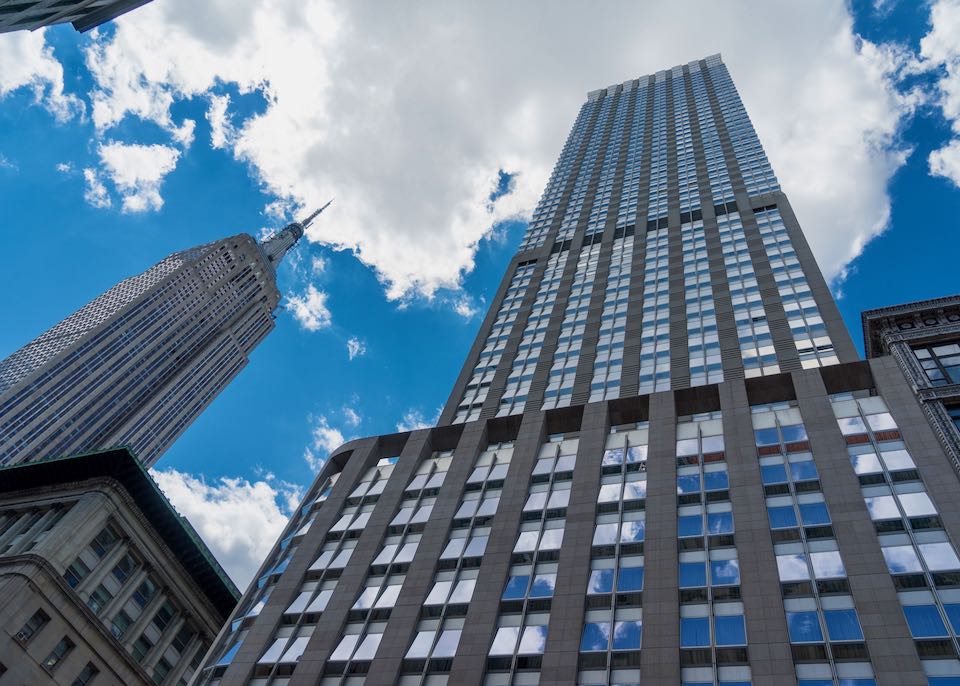
Hotel Phone: 212 695 4005
Sophisticated urban hotel with contemporary rooms and suites (1-4 beds) with floor-to-ceiling windows, Nespresso coffee makers, mirror tvs in the marble bathrooms & deep soaking tubs, and courtyard/street/city views. Upgraded rooms have full kitchens with Miele appliances (stoves, ovens, fridges) and walk-in wardrobes. Suites add sitting areas & terraces with unparalleled views of the Empire State Building (just two blocks away).
Check Prices on Booking.com
7. Pendry – Midtown West
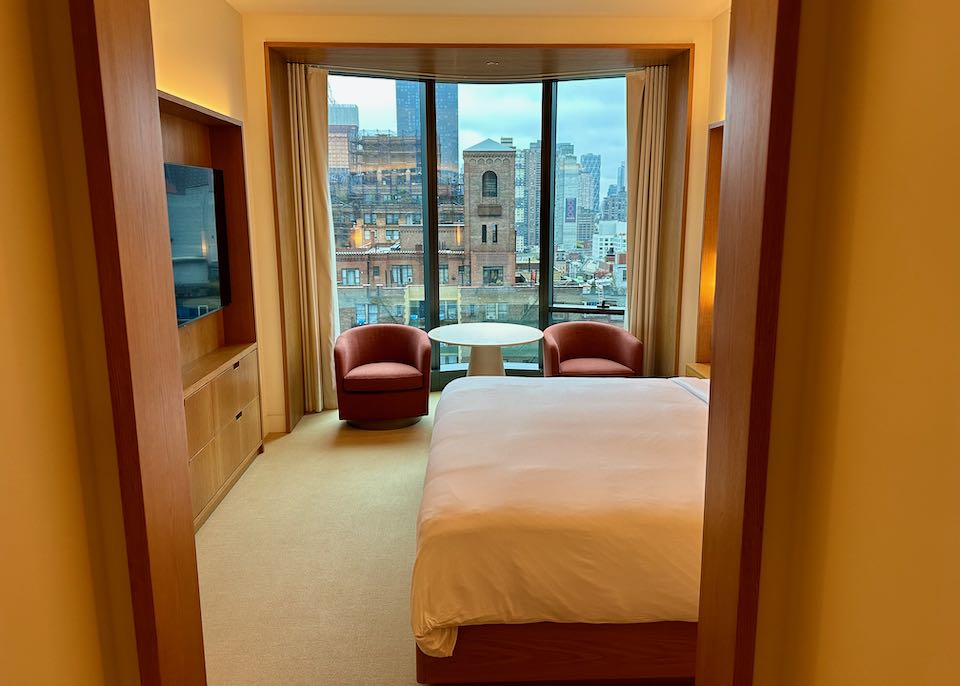
Hotel Phone: 212 933 7000
The best new hotel to open in Manhattan in several years. Trendy luxury with no stuffiness. One-bedroom suites comfortably sleep a group of 4. Short walk to Penn Station, Madison Square Gardens, and Hudson Yards (indoor mall). Steps from a Whole Foods grocery store, Starbucks, and the start of the High Line elevated walking path (one of my favorite outdoor attractions in the city).
Check Prices on Booking.com
8. Beekman – Financial District
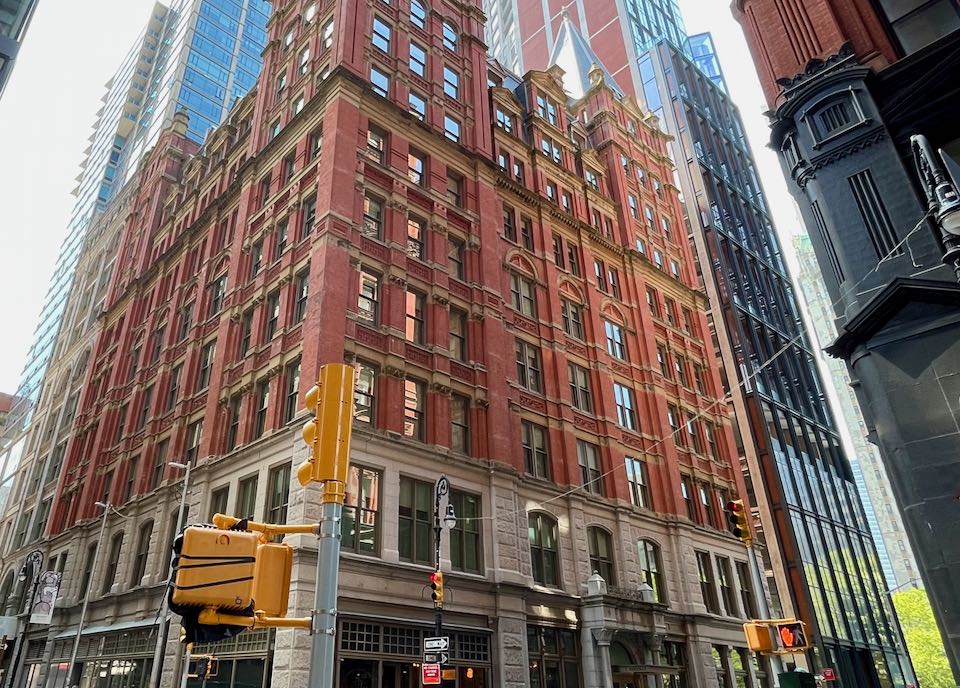
Hotel Phone: (212) 233-2300
Awesome luxury hotel located a short walk to Wall Street and the 9/11 Memorial and Museum. Several stunning restaurants. Rooms and suites are beautifully furnished. Penthouses are among the finest in the city.
Check Prices on Booking.com
Summary: My Favorite Hotels in Manhattan
• 5-star: Mandarin
• 4-star: Archer • Pendry
• 3-star: citizenM • Sheraton
• For families: Lowell • AKA
• For couples: Library • Crosby
• Times Square: Marriott
• Central Park: Pierre
• Penn Station: Renaissance
• Grand Central: Library
• Empire State Bldg: Langham
• Lower Manhattan: Crosby
• Financial District: Beekman
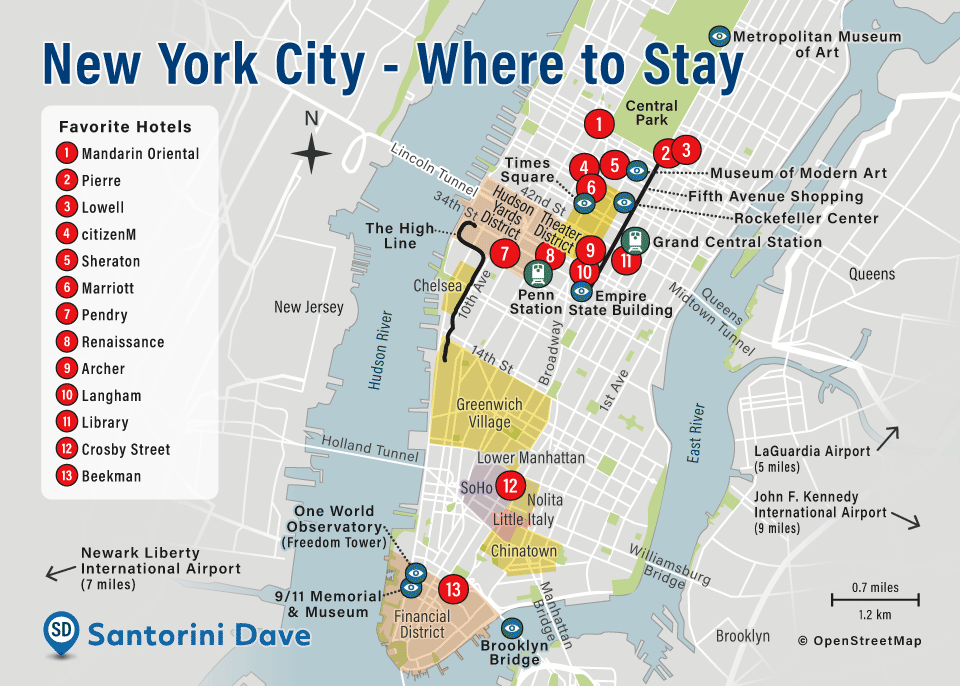
1. Mandarin Oriental • 2. Pierre • 3. Lowell • 4. citizenM • 5. Sheraton • 6. Marriott • 7. Pendry • 8. Renaissance • 9. Archer • 10. Langham • 11. Library • 12. Crosby St. • 13. Beekman
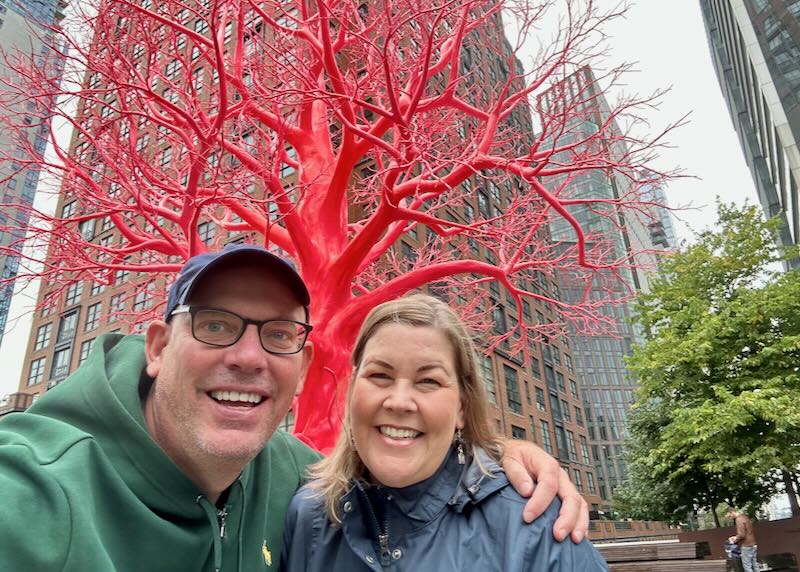
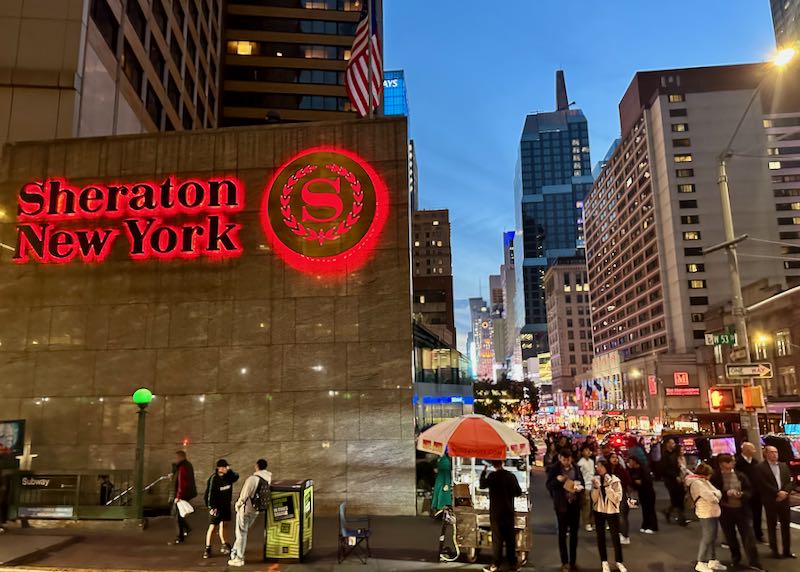
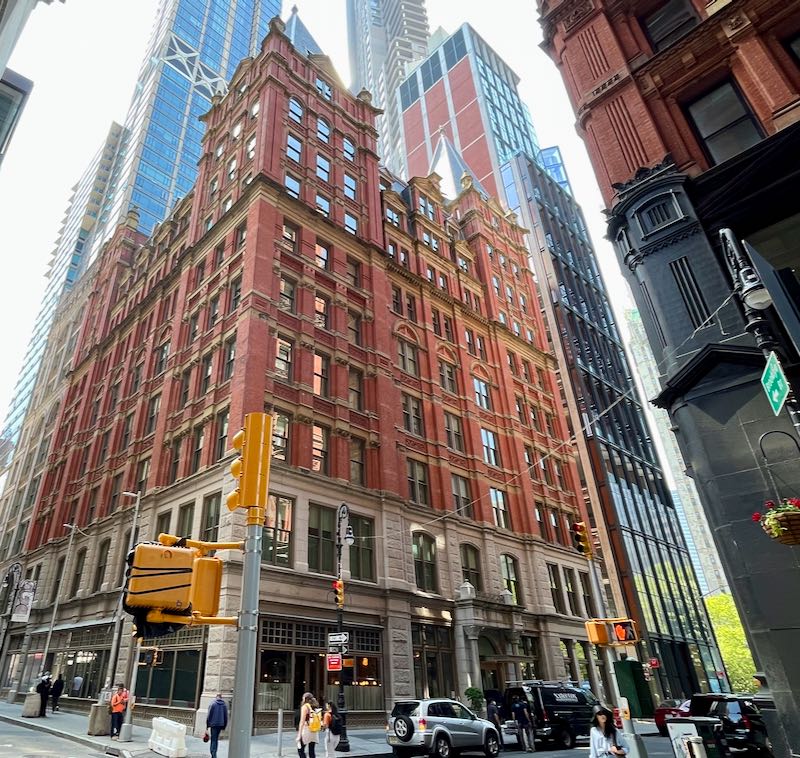
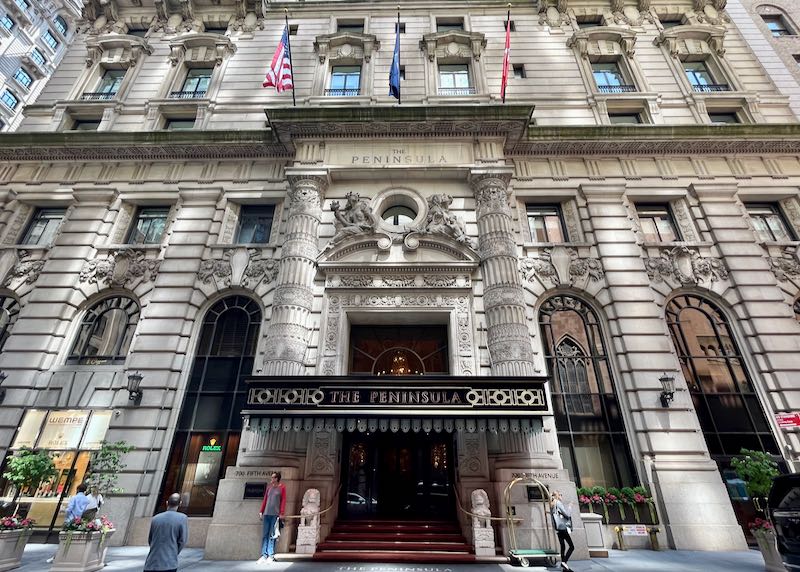
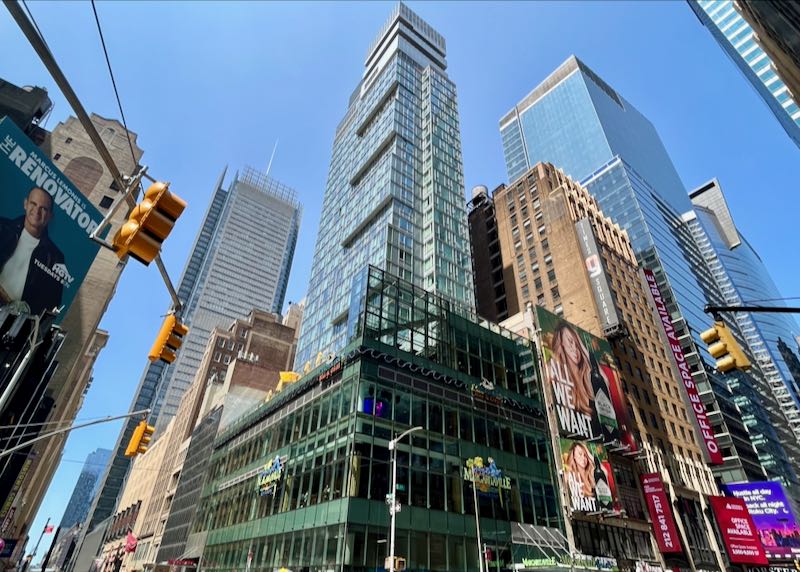
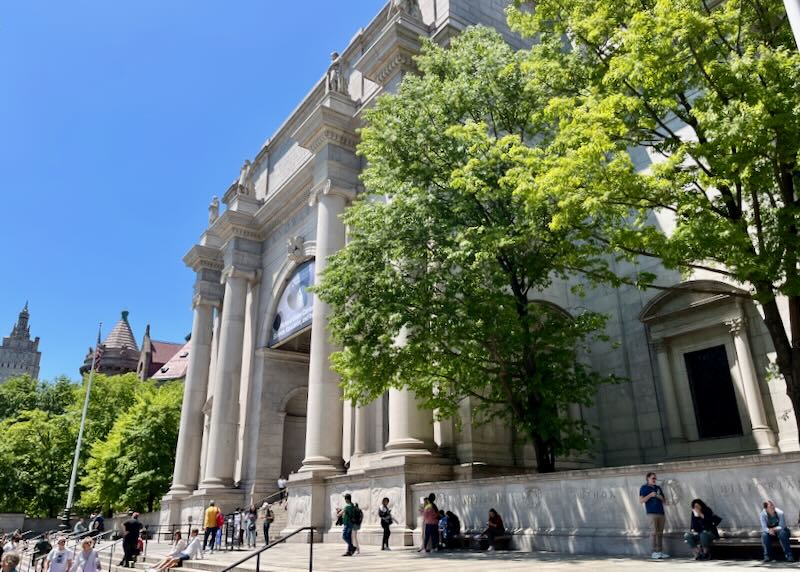
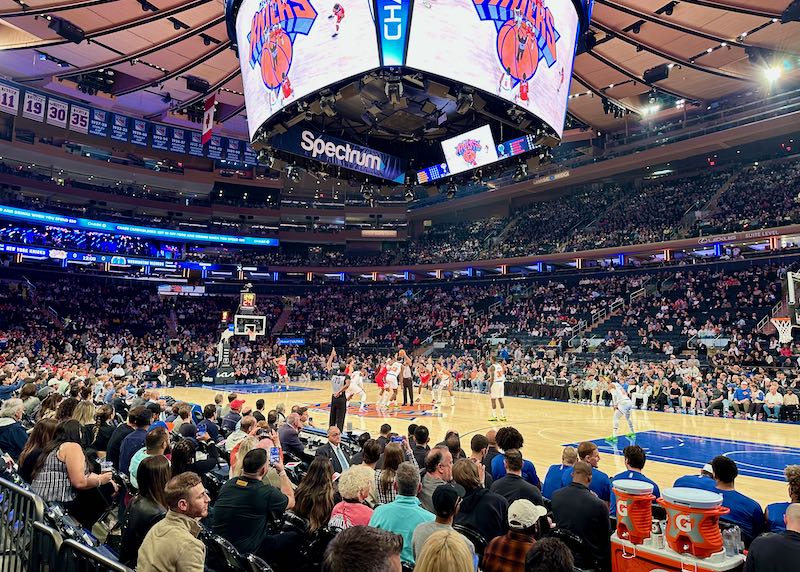
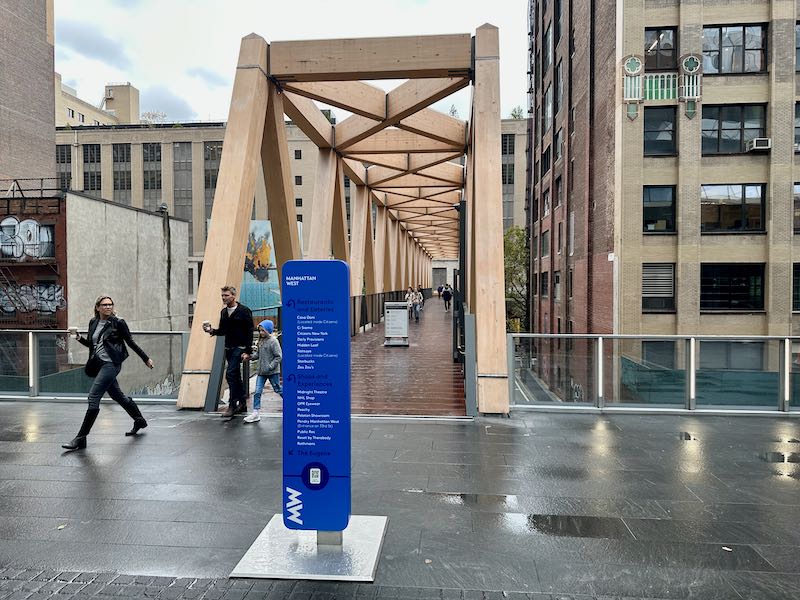
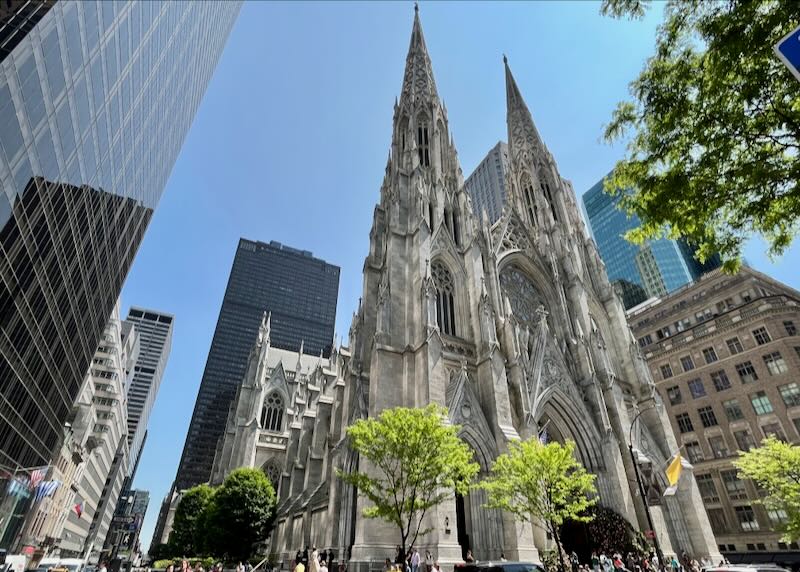

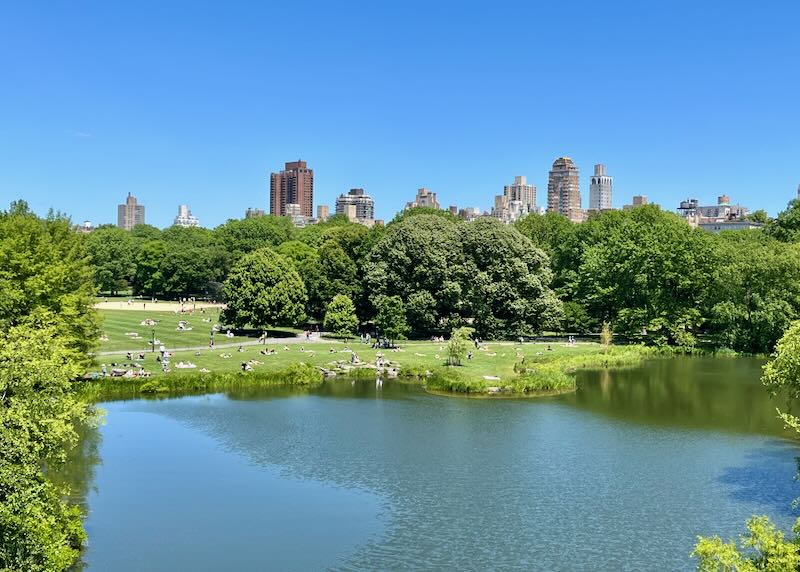

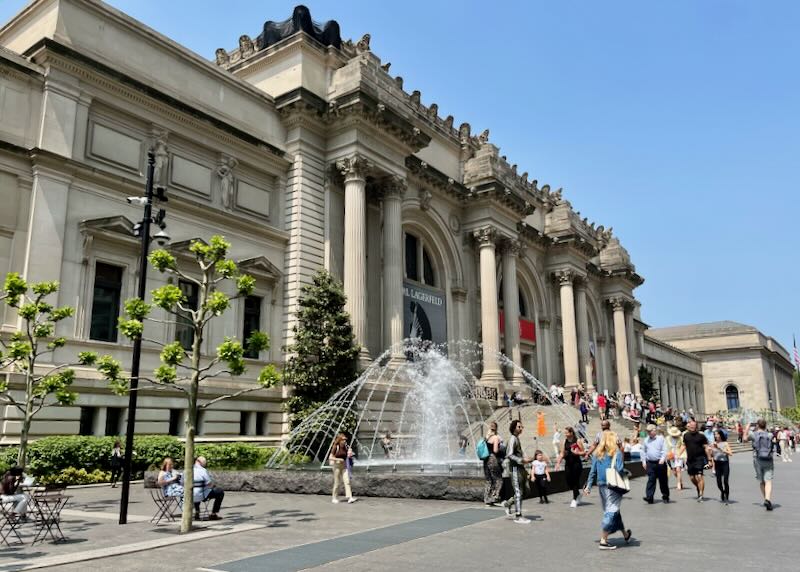

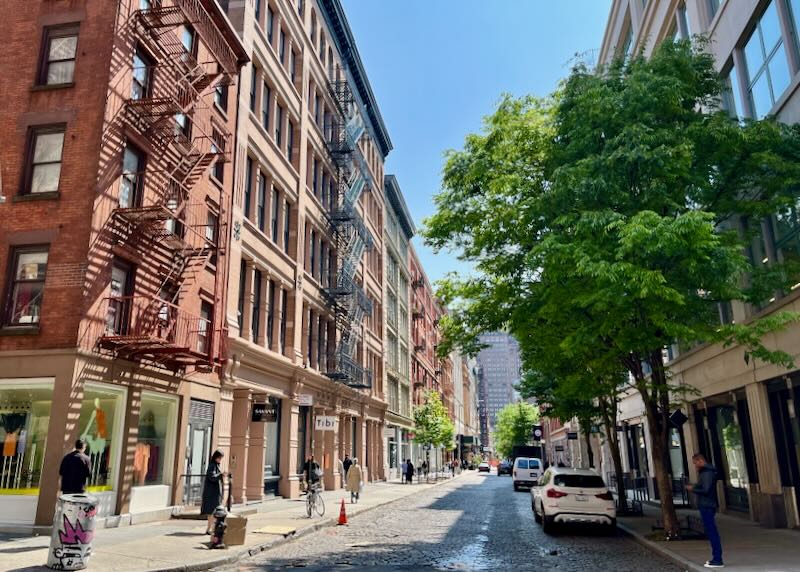

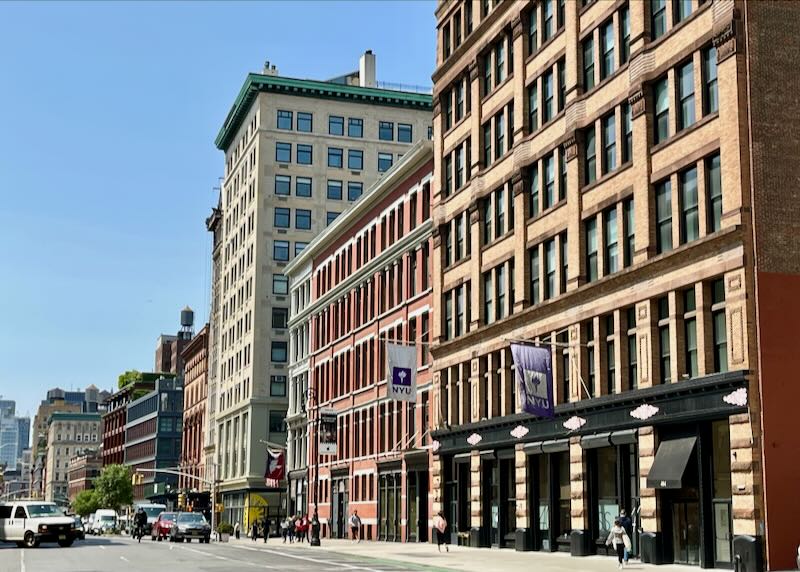

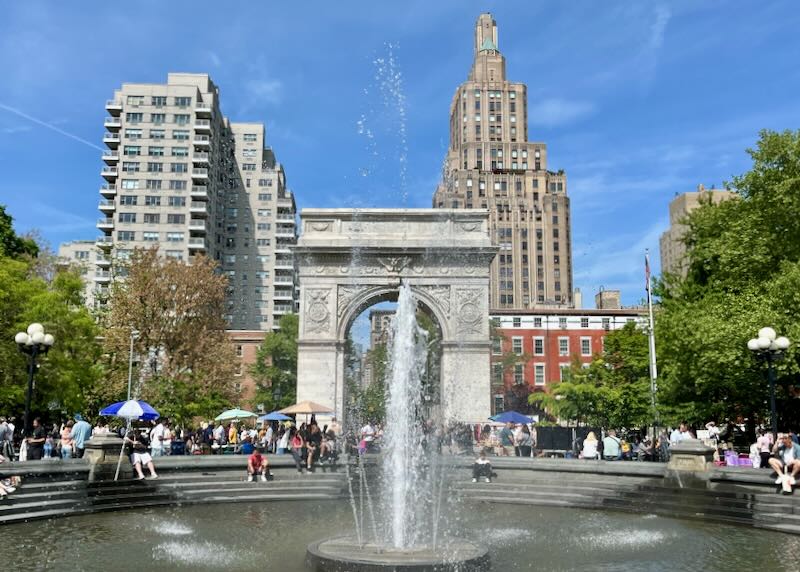

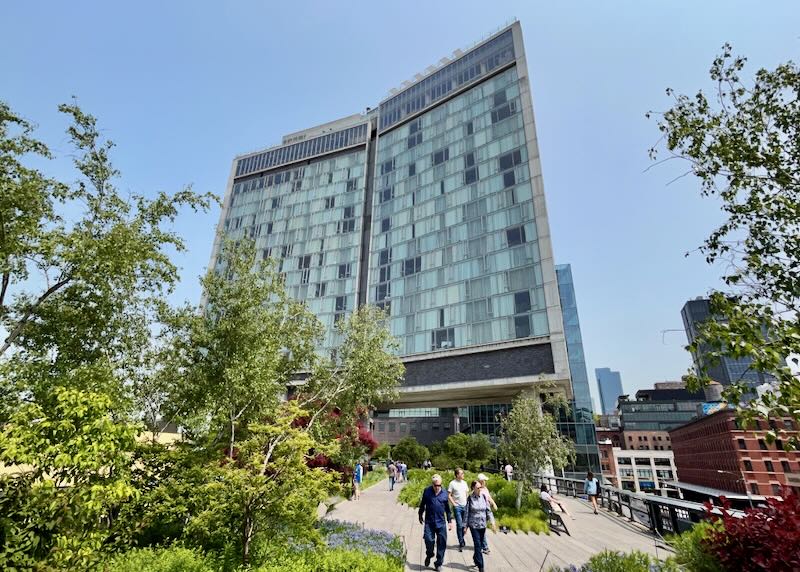

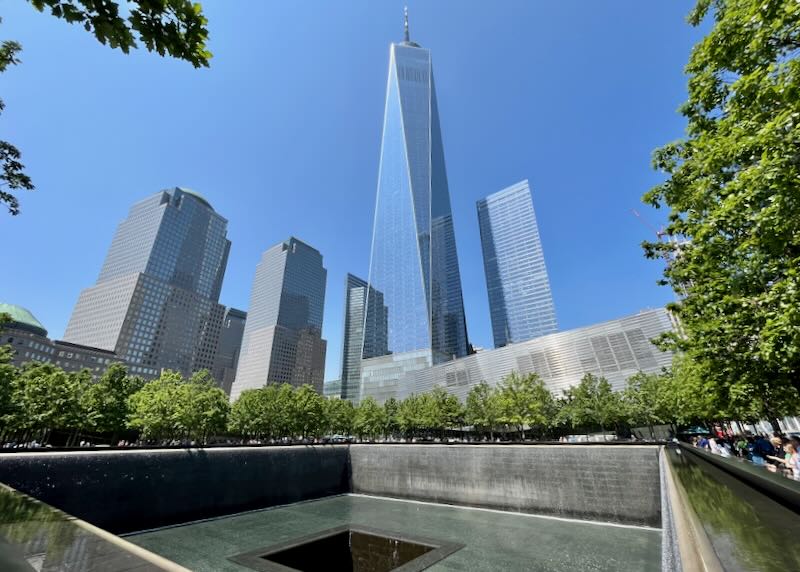

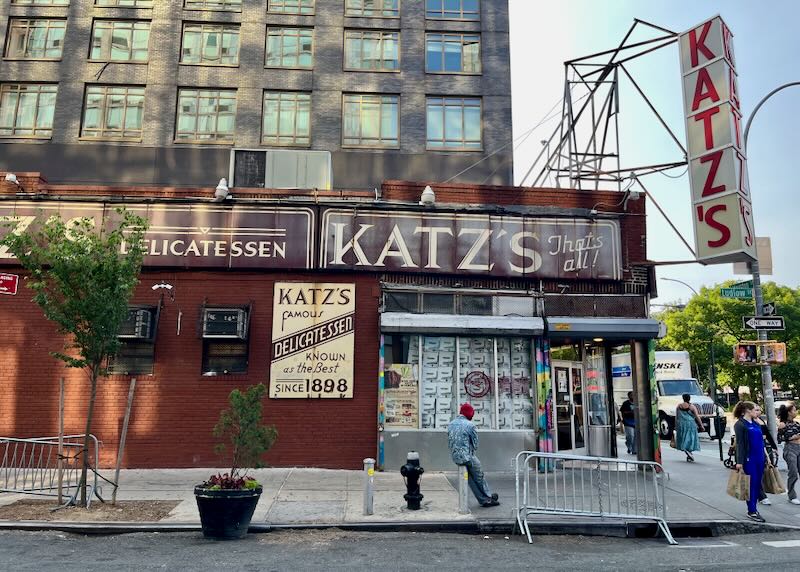

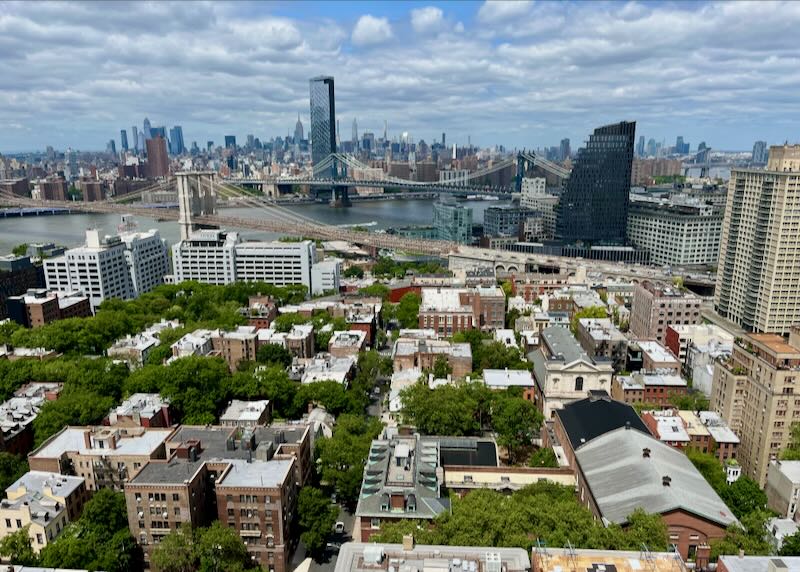

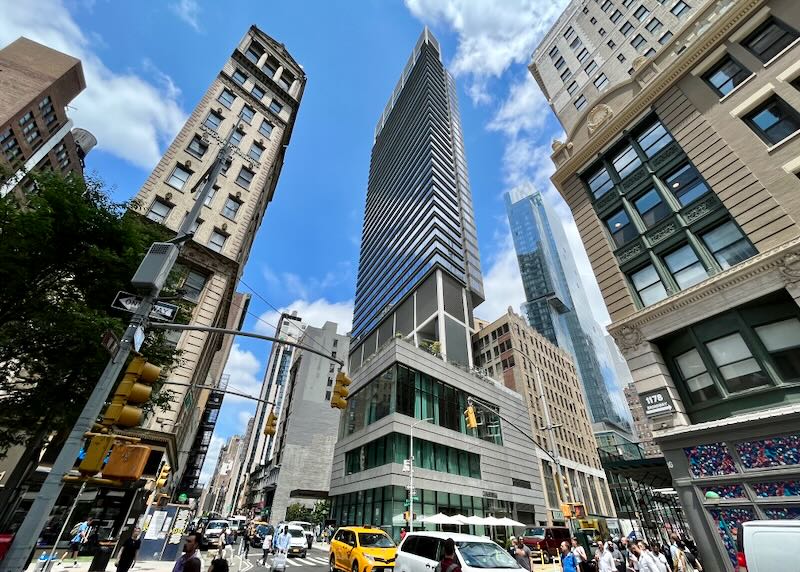
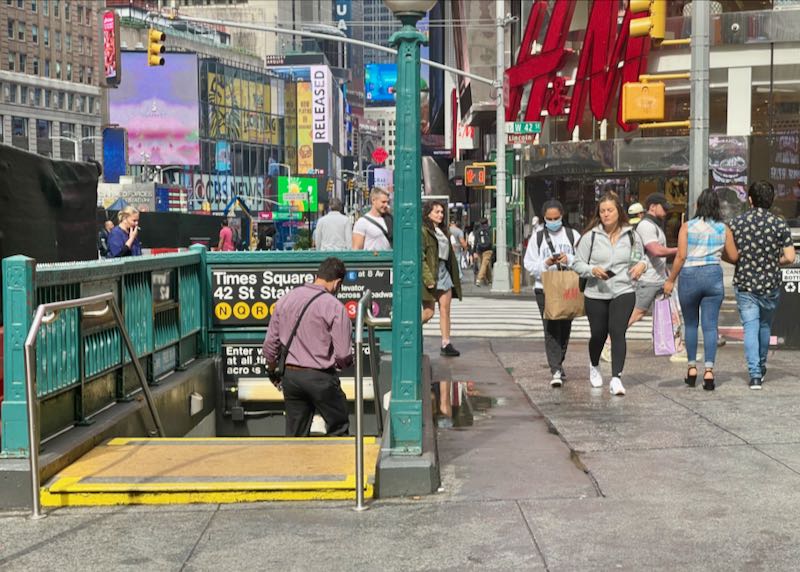
 I'm Santorini Dave. I started this site in 2011 with a short article on tips for visiting Santorini with kids. We're now a small team of writers and researchers dedicated to providing the best travel content on the internet. We focus on
I'm Santorini Dave. I started this site in 2011 with a short article on tips for visiting Santorini with kids. We're now a small team of writers and researchers dedicated to providing the best travel content on the internet. We focus on
Loved this post! I’ve been to NYC a few times but always struggle to decide where to stay. You’ve given me some great ideas for my next trip – I think I’ll have to try the West Village this time!
I love hearing that our stuff has been helpful. That’s our goal. Thank you.
Hi, traveling to NYC in April for the first time with families totaling 11 (age ranging from 3 to 79!). What sort of accommodation is best recommended for our group size – Airbnb or hotel, that are both clean, close to attractions and not cost us an arm. Thanks in advance for your guidance! :)
I think I would go with several rooms in a moderate hotel. Unless you can find an Airbnb for a large group – possible but not easy.
First time in New York and staying at Homewood Suites by Hilton Edgewater NYC. Would like to know if this hotel is safe and can give us easy access to most tourist attractions like Times Square and the Statue of Liberty?
The hotel offers a free shuttle to the ferry terminal on the New Jersey side, then you take a ferry to Manhattan ($9, each way), and then another free shuttle to get you to a few different popular spots in the city. I wouldn’t call it convenient, but not terrible either.
Hey! Thank you for posting all this amazing info. I am traveling solo to NYC for the first time and was thinking of staying in a hostel. What are your thoughts?
The HI NYC Hostel is the best hostel in NYC but it’s a little out of the way on the Upper West Side. Instead I’d recommend the Historical Blue Moon Hotel on the Lower East Side. It’s better located for bars, restaurants, and nightlife and almost as good.
Would you recommend Airbnb for Manhattan/Brooklyn? We are a family of 5 so apartment may suit us better and the AKA apartments you recommended have only 2 beds. I’ve heard that some Airbnb are not legal within NYC.
Thanks
I love the two-bedroom apartments at AKA and they do sleep five. Airbnb in New York City is a possibility but is very hit and miss. I’d stick with the hotel.
Hihi,
Will be travelling to New York this December for Christmas and New Year for Times Square. But the hotels near Times Square are so pricey. Would you help to recommend the good place to stay for a group of 3?
I suggest the Freehand Hotel in Midtown. It has cozy 3-bed and 4-bed rooms that are great value. (Some have boutique-style bunk beds.)
We are a family of 4 with two teens. Going to NYC for 1st time in October. Please can you advise on how to find a hotel that has interconnecting rooms. Need main room with double bed and connecting room with 2 separate beds. All searches so far come up with 2 doubles. Or would we need to have 2 seperate rooms? Thank you.
Interconnected rooms are rare. Take a look at the AKA Times Square. I’ve stayed here a few times. It has a great location and the 2-bedroom apartments with kitchens are perfect for families.
We are considering staying in Brooklyn to save money on a cheap hotel. Is this worth the money? Is it easy to commute from Brooklyn to Manhattan for sightseeing in NYC?
Brooklyn has some great areas and is a destination in its own right but (for most people) Manhattan is what they’re here to see and makes the best base for sightseeing. The big considerations are where in Brooklyn are you staying, how close is it to a subway stop, and how much money are you saving? If you are near a subway stop then getting into Manhattan will be quick and easy.
You are right on point with recommendations for NYC!
Angelique
Thanks Angelique.